
Exploring th� Pasta-bilities ® RESTAURANTS | RECIPES | WINES | FOOD | CULTURE Smart. Local. Delicious. JANUARY | FEBRUARY 2020 ISSUE 24-01 Celebrating 21 years at the forefront of local food and drink INDEPENDENT & ISLAND OWNED
LET'S CATCH UP: Little Jumbo
CHEF TRENDS 2020









SUNDAY FEBRUARY 16 2PM-6PM CELEBRATE ISLAND CRAFT WITH OVER 70 LOCALLY PRODUCED CRAFT BEERS AND SPIRITS - INCLUDING LAND & SEA, îLE SAUVAGE & SHELTER POINT. $25 TICKETS AVAILABLE NOW AT THE STRATHCONA HOTEL FRONT DESK & EVENTBRITE.COM TICKET INCLUDES 2x 4oz BEER OR 0.5oz SPIRIT TOKENS PLUS 1X FOOD TOKEN Follow us OAKBAYBEACHHOTEL.COM Victoria, British Columbia Coming Soon... A new Food & Beverage experience. SPRING 2020 Pardon us while we get fabulous! We will be closing Vista 18’s curtains January 2nd for some exciting upgrades! 2 JANUARY/FEBRUARY 2020
WELCOME TO OUR FIRST ISSUE OF THE NEW YEAR. You’ve made it through the holidays, and are looking forward to 2020.

In keeping with the New Year theme, Shelora Sheldan has asked chefs what their top pick for the ingredient of 2020 will be; what are they most excited to use this year. Adrien Sala takes a look at non-alcoholic beverages; they’ve come a long way from the Shirley Temple. And Adrian Paradis takes a look at pasta—the perfect dish on a dark January eve. We have recipes for making pasta and egg noodles from scratch and, of course, scrumptious fillings and sauces to go with them.
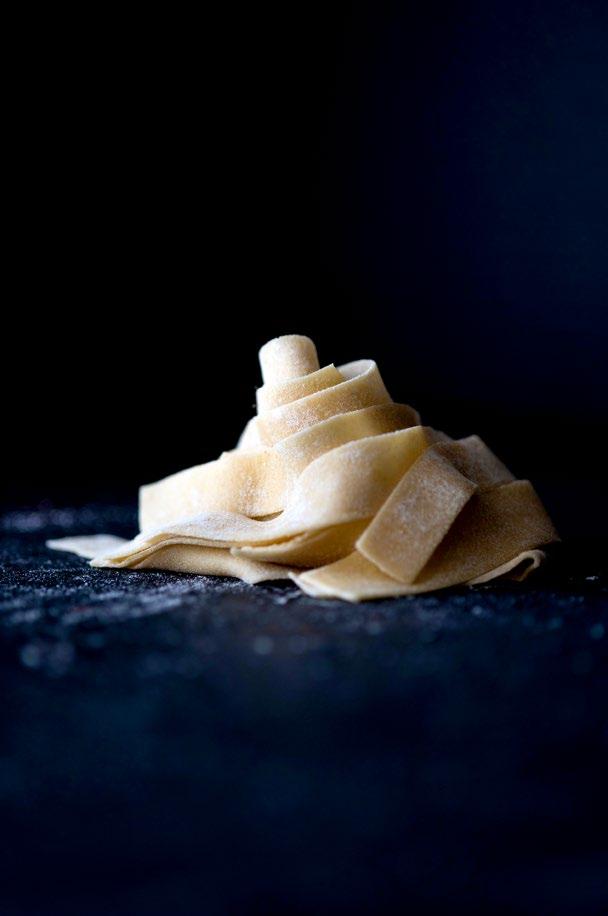
We’ve got a new Reporter column, Let’s Catch Up, and this issue we are back at Little Jumbo almost seven years after their opening.
EAT is 21 years young this year, and to celebrate we’ve brought back the Readers Choice Exceptional Eats! Awards, where our readers get to have their say—after all, they vote with their wallets every day. Please fill out the poll online at eatmagazine ca , give us your thoughts, and let your voice be heard. The results will be published in the March|April issue. We look forward to seeing who you pick!
Thank you to everyone on the EAT team—from the creatives to those printing and delivering the magazine. To our advertising clients, a big thank-you as well. Without your support, there wouldn’t be a magazine. To our loyal readers, a heartfelt Happy New Year!
CYNTHIA ANNETT-HYNES EDITOR
Cynthia Annett-Hynes
CITY EATS

Happy New Year, EAT readers! It’s that time of year when your social media feed starts filling up with photos of exotic places. If you are staying in Victoria this winter but still want to experience the taste of travel, check out the cooking class line up at the London Chef Throughout January and February your taste buds can travel to Italy, Spain and Thailand without ever leaving the city. thelondonchef com
The new year is always a quieter season for restaurant openings, making it the perfect time to visit some of the 2019 newcomers you may have missed. Wind Cries Mary (45 Bastion Square), Joie Grillades (104-1175 Cook Street) and Nohra Thai (2524 Estevan Ave.) are just a few that would all be good choices.
Seedy Saturday will be taking place in Saanich on Jan 11 , 10am-2pm, presented by and taking place at Haliburton Farm and featuring quality vendors, seeds, plants, starts, local wineries, seed exchange and a children’s table. Guest speaker Dan Janson will be speaking about Changing the Climate with the Seeds We Sow, the topic of his latest book. seeds ca

7 days a week | 5pm - 10pm Seating is limited, make your reservations now | 250.380.4458 463 BELLEVILLE ST VICTORIA, BC | HOTELGRANDPACIFIC.COM
The Pacific Restaurant at the Hotel Grand Pacific is excited to be once again offering our unique à la carte or three-course Fondue.
the cover
REBECCA BAUGNIET
On
Welcome
Styling
+
Photography: Rebecca Wellman
Visit eatmagazine.ca for more articles, recipes, news and events. 3
CITY EATS
Tourism Victoria and the BC Restaurant and Food Services Association’s 15th Annual Dine Around and Stay in Town will take place from Jan 17-Feb 2 Participating restaurants will offer three-course menus for $20, $30, $40 and $50 CND per person and are all paired with BC VQA wine suggestions. This year, Dine Around Victoria will officially kick off with the Dine Around Gala on Jan 16 . Hosted at the Victoria Conference Centre, the Gala will feature tasty bites from 60 local restaurants, wine and beer from VQA Wineries and B.C.’s finest craft breweries, and lively entertainment. Tickets are available online through Ticket Rocket. tourismvictoria com/ eat- drink /dine-around
Once again, the Hotel Grand Pacific is hosting the popular four-day Victoria Whisky Festival. Events include the Tenth Annual Canadian Whisky Awards Presentation and Dinner, masterclasses and grand tastings. Jan. 16-19. victoriawhiskyfestival com
Fine Vintage Ltd wine school here in Victoria offers WSET Wine and Sommelier courses. Wine tasting courses are available for wine enthusiasts and wine industry members including wine importers, agents, wine sales representatives, servers, sommeliers, wine store staff, winemakers and grape growers. The Level 1 course focuses on learning the art of wine tasting, pairing food and wine, and covers the characteristics of the major grape varieties. The full-day WSET Level 1 in Wines course is offered Feb 1 finevintageltd com
The Victoria Chinatown Lioness Club is pleased to invite you to their Annual Lunar New Year Fundraising Dinner celebrating the Year of the Rat. This is a unique opportunity to share an 8-course authentic Chinese dinner at the Golden City Restaurant, Feb 1 , 6-9pm. Tickets are $50 per person. victoriachinatownlioness com
Victoria’s Seedy Saturday will be held Feb 15 , 10am – 4:30pm and is hosted by the James Bay Market Society at the Victoria Conference Centre. The event will feature local seeds, plants, products, and speakers. jamesbaymarket com/seedysaturday
Looking ahead to March, Victoria Beer Week is a nine-day festival showcasing BC craft breweries in unique event settings. With a focus on education and diverse craft beer selection, VBW 2020 will feature more than 50 BC craft breweries at venues throughout the city. The Victoria Beer Week Society is a non-profit organization whose mission is to facilitate various beer-related events at locations around Greater Victoria. Mar 6-14 victoriabeerweek .com
The ninth annual Culinaire event will be held at the Crystal Garden on March 26 this year. This event provides locals with the opportunity to savour signature menu items and inspired dishes from an abundant selection of restaurants, lounges, pubs, cafes, specialty purveyors, and sip from a fine selection of local and regional wine, cider, and craft beer. Partial proceeds provide scholarship awards to the Camosun College Culinary Arts Program and a donation is made each year to the BC Hospitality Foundation.
culinairevictoria com
2020 is EAT Magazine’s 21st Anniversary.
Corrections:
Nov|Dec page 38 The Fab Four. Spicy Buttercup Queso is flagged as gluten-, nut-, and dairyfree. It is not nut- or gluten-free. Our apologies to our readers.
Nov|Dec page 50 Digestif: The Camosun Cuisine Machine Photos were incorrectly attributed to Rebecca Wellman. Heidi Fink is the correct photographer. Our sincere apologies to Ms. Fink.
To celebrate, we are bringing back the Exceptional Eats! Readers Choice Awards.
Let us know what you think, dear readers! Please do take your time and answer the questions that you want to and can answer. It is important and valuable to celebrate what is happening in food and drink and those who are making it happen. Discuss the Exceptional Eats! questions with friends and family, or simply mull them over with a glass of wine or your favourite libation.
FOUNDER
Gary Hynes
PUBLISHER
Pacific Island Gourmet EDITOR
Cynthia Annett-Hynes
EDITOR-AT-LARGE
Rebecca Wellman
CONTRIBUTING EDITOR/COPY EDITOR
Carolyn Bateman
VANCOUVER CONTRIBUTING EDITOR
Julie Pegg
SENIOR WINE WRITER
Larry Arnold
LAYOUT AND DESIGN
Cynthia Annett-Hynes
PRODUCTION AND DESIGN
Amanda Batchelor
REGIONAL REPORTERS
Victoria, Rebecca Baugniet
CONTRIBUTORS
Isabelle Bulota
Bill Blair
Joseph Blake
Nate Caudle
Cinda Chavich
Jennifer Danter
Jacqueline Downey
Pam Durkin
Gillie Easdon
Deb Garlick
Kyle Guilfoyle
Lillie Louise Major
Denise Marchessault
Sherri Martin
Elizabeth Monk
Daniel Murphy
Daisy Orser
Elizabeth Nyland
Adrian Paradis
Adrien Sala
Shelora Sheldan
Johann Vincent
Rebecca Wellman
REGIONAL/NATIONAL ACCOUNT MANAGER
Susan Worrall
ADVERTISING ACCOUNT MANAGER
Ron Metella
CONTRIBUTING AGENCIES
iStock.com pg. 9 32-33
FACEBOOK/EATMAGAZINE
TWITTER/EATMAGAZINE
INSTAGRAM/EATMAG
For advertising and other inquiries:
PHONE
250-384-9042 / 778-350-6962
EMAIL editor@eatmagazine.ca sales@eatmagazine.ca
ONLINE EatMagazine.ca
MAILING ADDRESS Box 5225, Victoria, BC, V8R 6N4

Who has the BEST food? drinks?
Thanks for your time! Polls are open until Jan. 31st. Cast your vote! Go to www.eatmagazine.ca - click on VOTE and be heard. It will only take a few minutes.
Results will be published and the winners announced and celebrated in our March|April 2020 issue.
STOCKISTS
EAT is delivered to over 200 pick-up locations in BC.

PRINTED IN CANADA
EAT® is a registered trademark. No part of this publication may be reproduced, stored in a retrieval system, or transmitted, in any form or by any means, electronic, mechanical, photocopying, recording, or otherwise, without the prior written permission of Pacific Island Gourmet / EAT Magazine.
EST. 1999

the st Anniversary Readers Choice AWARDS E x ceptional Eats!
JANUARY / FEBRUARY
Incorrect information appeared re: draw prize. See online survey for full entry rules and draw prize details.
4 JANUARY/FEBRUARY 2020

5
FORTIFYING FARE

Hearty winter brunches and lunches at Dosa Paragon and Italian Food Imports downtown, the Broken Paddle in Metchosin.

Dosa Paragon
735 YATES ST., NEAR BLANSHARD, 778-440-2406


Order a plain dosa at Dosa Paragon, and a flat, gold triangle the size of a platter will arrive at your table. What is a dosa? It is a dish native to South India—a delicious savoury crêpe made of fermented rice and lentils that can be eaten plain as a snack or with fillings as a meal. At this small but busy restaurant, these range in price from the flat plain one for $7.49 to a fat, folded one stuffed with butter chicken for $12.99—basically a gluten-free South Indian burrito. If you want a taste of the fiery side of South Indian cuisine, the Sambal Masala Dosa is the way to go, with fillings of softened potato and a hot chili sauce.
As a grizzled, long-time food writer, I am always thrilled when a restaurant can teach me something new. Here I got to try “idli” and “vada” for the first time. An idli is a round and puffy
rice cake made from fermented ground rice and lentil, with an intriguing texture like a British steamed pudding. The Sambar Idli dish at Dosa Paragon serves the idli in a lentil broth with a salted coconut chutney on the side; this goes for $6.99.
Since this small restaurant is in the same mall as the sweet offerings at Empire Donuts, I find it amusing that at Dosa Paragon you can get a savoury lentil doughnut—doughnuts from end to end! These lentil doughnuts are called vadas and have a bready texture despite having no flour. They are perfect for ripping apart and dipping into chutneys and sauces.
You simply can’t go wrong here. The paneer and cauliflower bites are toothsome, and come with zesty sauces. They serve up pineapple lemonade with a hint of cardamom. And the South Indian coffee involves a bit of drama, with presentation in a narrow, tin cup on a metal ramekin. Dosa Paragon is an important addition to the Victoria food scene.
Moss Street Winter Market Saturdays, 10am to 1pm November through April Local, organic farmers, bakers, distillers, vintners, coffee roasters, and an amazing variety of baked goods, preserves, produce, sprouts, prepared foods, eggs, meats, and much, much more. MossStreetMarket.com Now expanded in size and hours!! Indoors, at Sir James Douglas school Market Farmers Moss St. Est. 1992 Eating Well for Less
ELIZABETH MONK
CAULIFLOWER GOBI AND SOUTH INDIAN COMBO PLATE 6 JANUARY/FEBRUARY 2020
ELIZABETH NYLAND
The Broken Paddle Coffee House


4480 HAPPY VALLEY RD., NEAR METCHOSIN RD., METCHOSIN, 250-474-2999


At Broken Paddle, it feels like you’re relaxing in a friend’s cabin—if your friend’s cabin is also a community hub. You can have all-day breakfast, or soup and sandwiches. It closes at 3 p.m. Sunday to Friday and isn’t open Saturdays, so it’s a “get on down there” scenario.
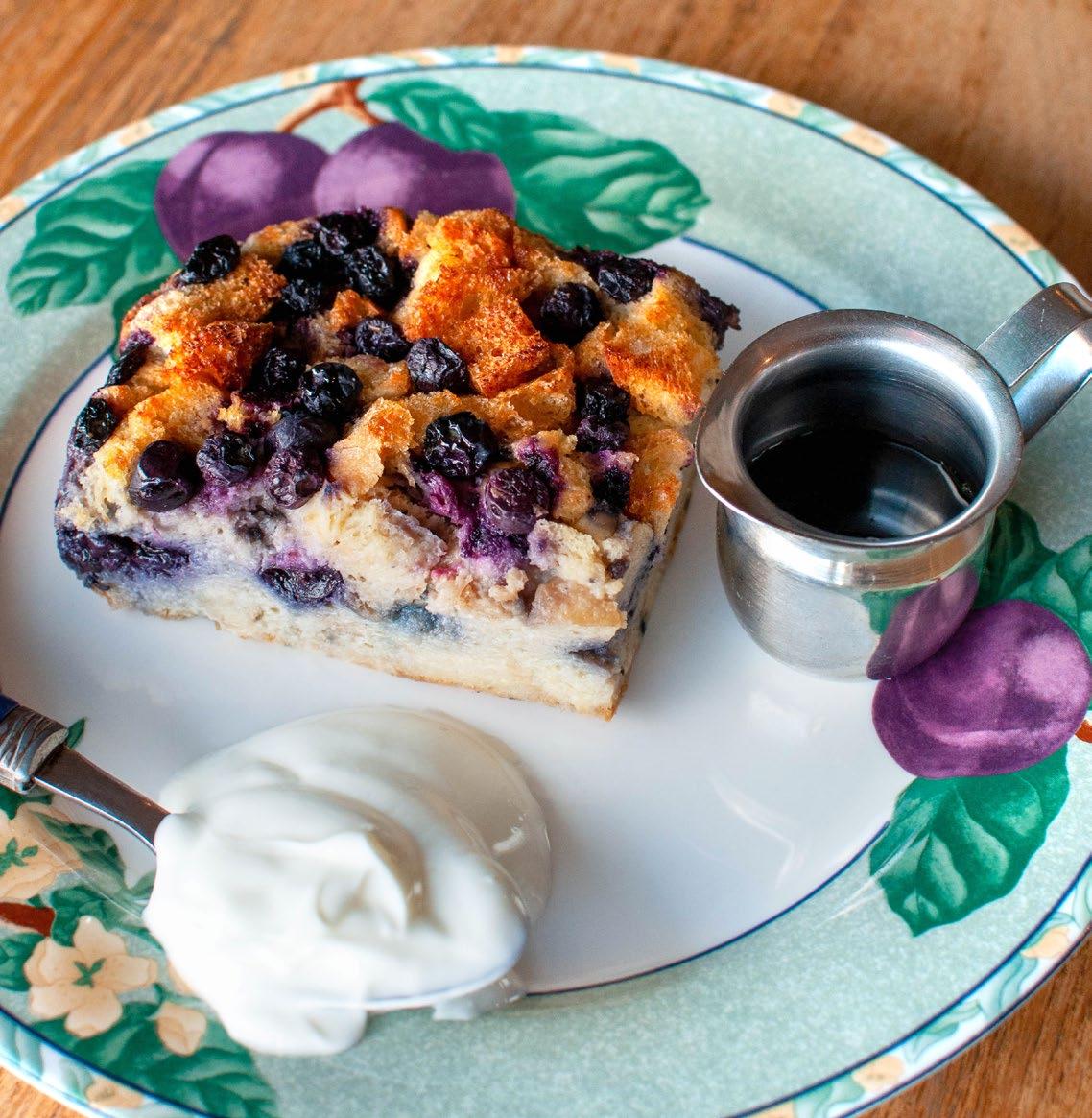
The best-seller is the Broken Egger for a manageable $4.80. It’s a classic ham and egger in an English muffin, but what makes it special is that the egg is from a farm practically around the corner, and there’s a layer of braised Metchosin greens. The Blueberry French Toast would be equally at home on a high-end hotel brunch menu. Its name is something of a misnomer, as it is actually a rich and moist blueberry bread pudding, flanked by a small pitcher of maple syrup and a dollop of Greek yogurt. The main difference from a higher end place is that the food is served on a mishmash of grandma’s kitchen dishes and you get your own water, but $6.75 for this dish is still exceedingly fair if not underpriced.

On the lunch menu, the grilled Rosemary Ham and Havarti Sandwich is as advertised, but again, it is elevated: the bread is homemade, the outside is spread with lots of butter to make it extra tasty and crispy, and a smear of Dijon announces itself but does not overpower the sandwich. It’s $8.60. Have I mentioned that all of the prices listed include tax?
The name “Broken Paddle” has a double meaning for owner Shannon Meeker. At a time of great change in her life, and before the establishment of the café, she took up outrigger paddling. Later, she learned some lore from a First Nations friend that if a paddle breaks and you can’t steer, then life has to take a direction you didn’t anticipate. The result for our community is Broken Paddle Café.
BLUEBERRY FRENCH TOAST
7
ELIZABETH NYLAND
Italian Food Imports


1114 BLANSHARD ST. NEAR VIEW, 250-385-7923

Classic but not old school. Italian Food Imports, in town since 1985, has everything you would want in an Italian deli: delicious food, groceries for sale, and the bonus of charismatic owners who want to check on how your experience was.
They keep their menu simple here—sandwiches, soup, one pasta of the day. The Grilled Muffalatta for $8.43 is delicious. This sandwich was invented in New Orleans at a Sicilian deli. Three meats—prosciutto, mortadella, and Genoa salami—are the mainstay, with some bocconcini for the melt. But what makes it special is the muffalatta spread made with lots and lots of olives, celery, carrots, and artichokes, and dashes of oil and red wine vinegar. The result is a saucy sandwich with a punch of salt and umami, grilled to a golden crisp. Salads are sold by weight, and choices are plentiful. In the “hearty” family, the Sicilian Chickpea Salad had an interesting mix of spicy sausage offset by creamy chickpeas. And the Italian Chopped Salad mixes Abruzzo salami, turkey, and provolone, along with grated carrots and purple cabbage. In the “dainty” family, the Caprese Italiana had classic matchings of cherry bocconcini, grape tomatoes, kalamata olives, and artichoke hearts.
This place is so popular, they don’t even have soup of the day: they call it “soup of the moment.” In my moment, it was a roasted poblano soup with white Cheddar that was hearty, deliciously creamy, and complex. Meats and cheeses are for sale here, as are dry goods. The Tiberino one-pot meals are a new Italian product that look promising. Italian Food Imports has classic foundations but also brings in the new.
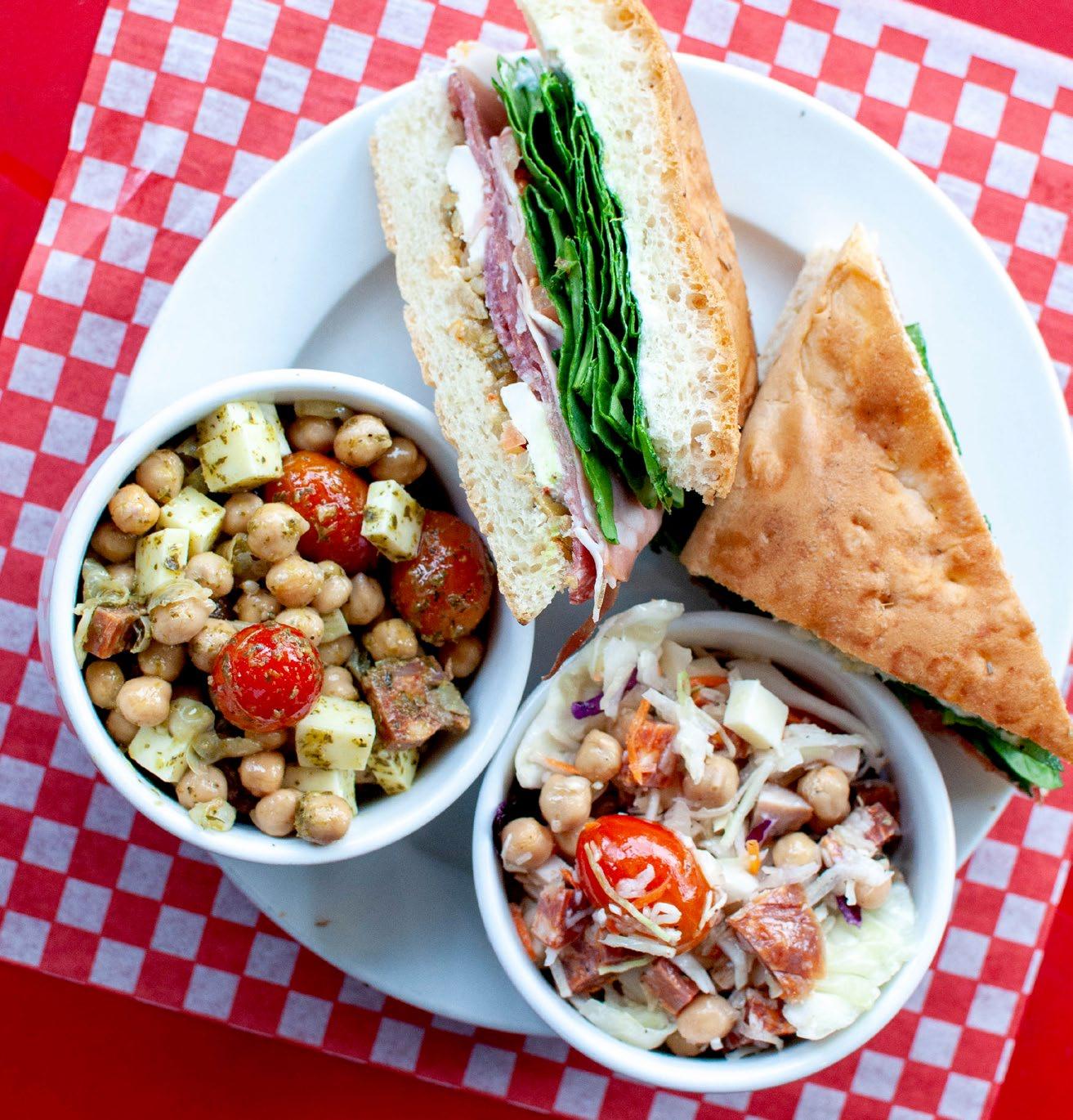
ELIZABETH NYLAND 8 JANUARY/FEBRUARY 2020
MUFFALETA, SICILIAN CHICKPEA SALAD AND ITALIAN CHOPPED SALAD
Get Fresh PLEASE DON’T MAKE ME SAY ZOODLES
Spiralized vegetables are nutritionally robust, beautiful, and deserve a name that doesn’t make us snicker every time we say it.
I FIND IT SILLY SOMETIMES how the English language works. When lacking a word for something, instead of putting thought into the most appropriate word for that need, we just adopt whatever slang social media has manifested to fill the void, leaving us with a word like zoodle for something healthy, adult, conscientious, and delicious. How are we supposed to take zoodles seriously? Are nutritionally focused restaurants really expected to put that on their menu? It sounds like kid’s food (joke’s on them), and for most of us suggests gloppy, nutritionally void, animal-shaped pasta that came from a can in the 1980s.
I also find it humorous that so many food trends, like this one, are considered “new.” All of these things have existed and been enjoyed by the fringe for decades. I grew up on (and was thoroughly embarrassed by) kombucha, wheatgrass, nut cheeses, seitan, and, yes, “ribboned vegetables.” Let’s give this “trend” some traction by doing it right. Let’s make “zoodles” the new sliced bread.
In this case, doing it right is easy. And if your goal is to convert your pasta-loving family to ribboned vegetables, then doing it right is essential. Serve up a plate of soggy zucchini noodles, and you’re facing an uphill battle. I suggest tossing aside the notion of replacing pasta with veg. My family accuses me of “tricking them” all the time, when, in fact, I didn’t intend to. I make a shepherd’s pie recipe that is meant to be made with cauliflower, but it looked like it had potato on top. It’s not a substitute; it’s a different recipe, one that shouldn’t be compared, just appreciated. You aren’t fooling anybody with veggie noodles as a pasta substitution. Introducing them as a delicious new household menu item, however, is your “in.”
Your spiralizer options are vast, from hand-held to countertop; you can even get your toes wet by using your veggie peeler. Generally you’ll be getting your money’s worth if you invest a little bit, but consider your frequency of use, counter space, and general tolerance of gadgetry before splurging.
When choosing veggies or fruit to spiralize, you will have the most success with firm, not floppy, and long shapes (or veggies that can be cut into long shapes). I suggest choosing something you know you will find delicious to start with, and perhaps something you plan to eat raw. Maybe a finely spiralized carrot and beet for your salad, or a super-simple Asian cucumber ribbon salad. Once you’ve mastered the noodling itself, move on to veggies you plan to cook.
Veg-forward eating isn’t going anywhere, but methods to make it more inviting to the vegetable-restrained members of our population are still needed. Ribboned or noodled vegetables, if prepared mindfully, are anything but gloppy, are nutritionally robust, beautiful, and deserve a name that doesn’t make us snicker every time we say it. If someone would please start a petition, I’ll be happy to sign it.
SPIRILIZE THIS:


Apple/pear: Leaving the skin on or taking it off is a personal preference, but don’t remove the core. Spiralizing these fruits cuts way down on prep time and gives you a fun texture for your fruit crisp or pie.
Potatoes/yams/sweet potatoes: All prepared (best peeled) and used similarly. Let the sweetness be your guide when choosing how to prepare, but curly fries are an obvious winner here.
Jicama: Peel it first and proceed as you would with a potato. In fact, you can replace potato with jicama in many recipes if your aim is to keep carbs low. Or use it as a base or complement in any Asian slaw recipe. Try flash-frying the strings in hot oil and sprinkling with salt for savoury little nests of flavour.
Daikon radish, kohlrabi, and broccoli stem: Like jicama in texture, but with a bit of radish-y zip, these are fun additions to slaws, or any salad, and also delicious cooked; I love them roasted. Peel first and play with substitutions or make a fridge pickle (if you’re intimidated, check out Islandbrinecompany.com. They make masterful quick-pickling so easy
and delicious) to complement Asian dishes, burgers or cheese boards. Pretty much any meal is elevated by a “quickle” (now there’s a coined word I can get behind). I’m a fanatic.

Beets and carrots: These are ideal for the spiralizing novice. Nice and firm, hold up well when cooked but also delicious raw. I love them super thin on a salad, wrap or sandwich, or as a topping for soups. Peel if you want to avoid the earthy taste, but leave skins on if umami is what you’re going for.
Onions: You won’t really get a “noodle shape” from an onion, but once peeled, leave the root end intact and spiralizer to reduce chopping time and save yourself from onion tears.
Zucchini and summer squash: Delicious raw or cooked, and they adapt well to so many flavours, but if you plan to cook them, once spiralized, lay them out on a towel and sprinkle with salt to draw out the excess moisture; pat dry before proceeding with your recipe to avoid a mushy outcome.
Butternut squash: Better safe than sorry; this is the most common vegetable to be noodled. Peeling your squash is the hardest part (and use only the neck so look for long ones), spiralize, and oven roast or sauté.
Rutabaga (turnip): I use rutabaga in place of potato pretty much exclusively in our house. Soups, roasted veg, oven fries, the world is your oyster. Peel first and get creative.
Cabbage: You don’t really get much of a “spiral” out of cabbage, but you get a super-efficient way to make slaw, and you can play with the different textures. I like a really fine slaw if I’m using it with tacos, for example.
Fennel: Treat fennel as you do the onion, and please just eat more fennel. Use it in your slaw, roast it, add to soups, pickle it. This veg is under-loved and playing with textures just opens up your options.
We are bottling
COOLSHANAGH.CA
Naramata geology
DAISY ORSER
ILLUSTRATIONS ISTOCK.COM/KHALUS 9
Daisy Orser is co-owner of The Root Cellar Village Green Grocer
Dumpling Days
The secret to pinching perfect perogies.

WORDS + PHOTOGRAPHY
Cinda Chavich
Full disclosure—I may have a perogy problem.
My devotion to these little dumplings is rooted in childhood memories of my grandmother’s steamy kitchen and her tender perogies filled with potatoes, cheese, mushrooms, and even plums. We slathered them with sour cream, doused them in buttery fried onions, and ate them with smoky garlic sausage on the side. It’s my definition of comfort food.
Such is my penchant for these Eastern European staples (pyrohy, pierogi, varenyky), I’ve even followed Alberta’s Perogy Trail, touring Edmonton’s Willy Wonka-esque frozen perogy factories, visiting “living” Ukrainian museums where costumed docents cook dumplings, and driving dusty backroads to see the world’s largest perogy, a towering 27-foot perogy-on-a-fork sculpture in the tiny town of Glendon.
In my family, perogies turned up at both everyday dinners and holiday celebrations. The delayed Orthodox (a.k.a. Ukrainian) Christmas in early January was always a time to create, and consume, perogies. So gathering to pinch perogies in midwinter makes perfect sense.
At Bella Montgomery’s Perogy Pinchers of Victoria cooking classes, you can learn about making perogies, island-style, year round. “We started small, with ten or 12 people, and now routinely have 25,” says Montgomery of the hands-on, two-hour classes she runs at various community centres, church basements, and other venues around town. “I bring the dough and we mix up the filling and learn to pinch perogies.”
When Montgomery moved to Victoria from the prairies, she started making perogies, using her own family recipe, as a way to stay connected to her Ukrainian roots. Many of the others who join her perogy classes have childhood memories of delicious dumplings, too. But, like me, they don’t often take the time to make perogies.
That’s because the job of pinching perogies—like making Chinese dumplings or samosas or any other fiddly food—is best when it’s done collectively. Many hands make light work, as they say, and many hands make many perogies, tasty treats that can be frozen and saved to eat another day.
“It makes it a heck of a lot easier,” says Montgomery who recalls family perogy-making sessions, turning out “50 or 60 dozen at a time” for holidays and other events. Which is the other attraction to today’s perogy class—everyone arrives with their mixing bowls and baking trays, with the promise of leaving with their own perogies to take home.
Making perogies is simple, less recipe and more technique. There’s a basic dough to mix, a filling of seasoned mashed potatoes, often combined with shredded cheddar or sautéed onions, and that’s it.
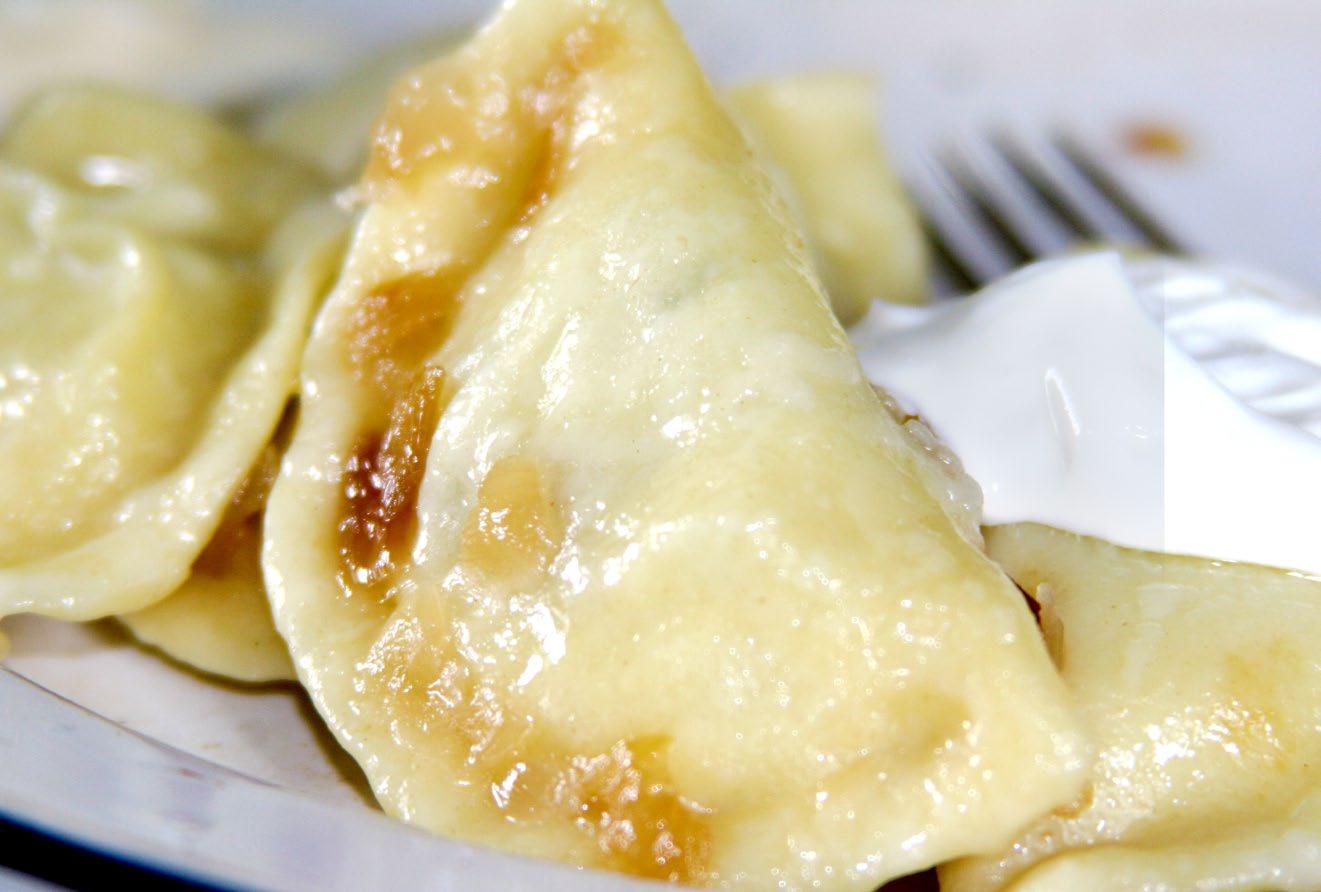
Every grandmother has a slightly different twist. Montgomery uses sour cream and flour (no eggs) in her tender perogy dough recipe. When I was a kid, we sometimes added mashed potato to the dough, too, for a soft, almost gnocchi-like wrapper.
Others prefer their perogies with a thin, translucent skin—a pre-made egg roll wrapper can stand in for hand-rolled dough to save time, just make sure to wet the floury edges to get a good seal.

The mashed potato and cheddar cheese filling is probably the most popular today, but you can also find perogies filled with sautéed mushrooms and sauerkraut, cottage cheese, even meat or fish.
Don’t use too much filling. It’s important to make sure the edges are clean so you get a good seal or perogies may burst open when boiled. A three-inch diameter perogy holds about a teaspoon of filling. Pinch gently, says Montgomery, pressing the edges shut with the pad of your thumb after folding the dough over the filling. (Traditionally, perogies were never sealed with a fork or metal utensils to guard against puncturing the dough.) Put filled perogies into boiling water, with a touch of oil and salt, and stir gently with a wooden spoon until they float to the top, then remove carefully with a slotted spoon
The origin of the perogy (pierogi) is debatable—dumplings feature in Slavic cultures, from Ukraine, Poland, and other points across Eastern Europe but thanks to early immigrants from these parts of the world, it’s a peasant food that’s found its way into our food culture.
Today, perogies are as ubiquitous, and Canadian, as poutine and Nanaimo bars, with chefs riffing on the dumpling for breakfast, lunch, appies, and dinner. You’ll find local food trucks that specialize in perogies; restaurants like Victoria’s Sült Pierogi Bar with diverse perogy fillings and toppings (think barbecue tofu, kimchi and black
Perogies with buttery fried onions and sour cream.
10 JANUARY/FEBRUARY 2020
bean, or mango and chipotle chicken tinga); perogies with eggs for breakfast; even Pierogi Pizza topped with garlicky cream, bacon, fried potatoes and cheese at Fifth Street.
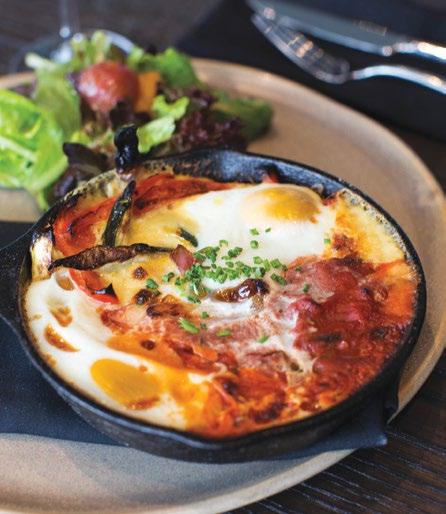
According to my vintage copy of Traditional Ukrainian Cookery by Savella Stechishin, published in Winnipeg in 1957 and the last word on the topic, varenyky (her nomenclature), should be “tender and with a thin coating of dough.”
It’s interesting to note that Stechishin’s traditional recipe has only four ingredients but a full page of instructions for mixing, kneading, rolling, filling, and cooking the dumplings.
So gather your friends, your family, and your kids and host a perogy party. Practice makes perfect when it comes to pinching perogies!
Perogies to Buy
Too busy to pinch perogies? Here are some local sources of handmade perogies to buy and cook at home:

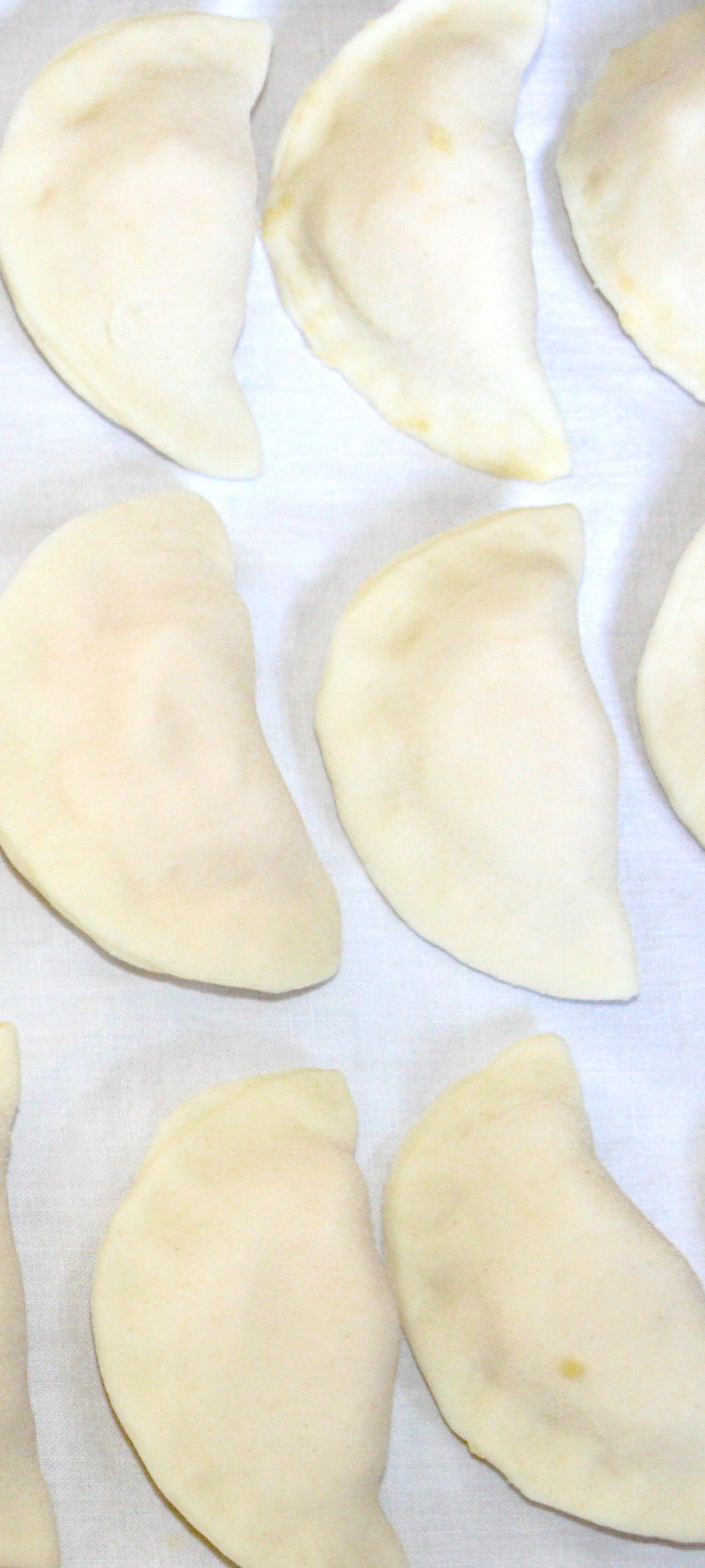
Cook & Pan Polish Deli:

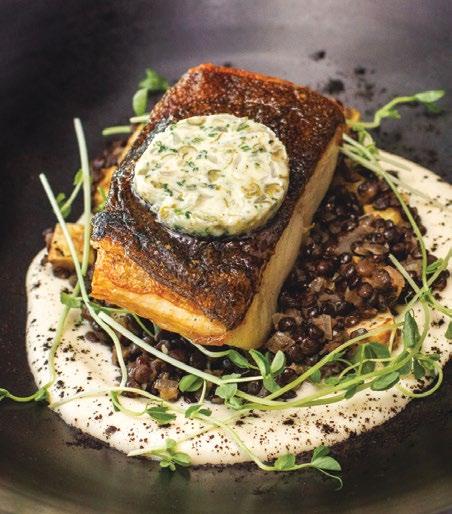
1527 AMELIA ST, VICTORIA | 250-385-5509 | COOKNPAN.COM
Stop in to their downtown location for a pierogi lunch with Polish bacon or scoop up a bag of their handmade pierogi from the freezer (potato, sauerkraut and mushroom, meat or blueberry). $7.50/doz.
Ukrainian Canadian Cultural Centre:
3277 DOUGLAS ST, VICTORIA 250-475-2585 | UCCVI.COM
You can enjoy a Ukrainian supper the last Friday of every month (5 p.m. to 8 p.m. with music, perogies, and cabbage rolls), or buy handmade perogies from their freezer. Call ahead (250-475-2585) to inquire about availability.
Perogie Pinchers of Victoria: 250-634-3108
Go online at perogiepinchersofvictoria.ca to book a class or find Bella Montgomery’s perogies frozen at local retailers, including The Market Garden in Vic West and Artisan Kitchen in Saanich (potato/cheese, cottage cheese/potato/dill, or sauerkraut/bacon) $9.50-11.25/doz.
See Cinda's perogy recipe at eatmagazine ca /perogyrecipes

11
Pinching perogies - Ukrainian Cultural Heritage Village museum, Alberta
Good for You THE BAR BIZ
All energy bars are not created equal. Here are three new ones that deliver healthy goodness on the go.
CONSUMER DEMAND FOR HEALTHY and convenient snack options continues to grow in Canada. With our busy schedules and ever-growing to-do lists, healthy “fuel-onthe-go” has become a de rigueur lifestyle requirement. Not surprisingly, Canadians rank third globally when it comes to the consumption of energy/protein bars. And there’s good reason for our enthusiasm. The bars are portable, tasty, and the perfect solution when the “hangries” strike. Unfortunately, not all energy bars are created equal, nor are they all healthy—many are overly processed and contain deleterious ingredients and copious amounts of sugar. Thankfully, some new players in the “bar biz” are standouts when it comes to delivering taste and nutrition, and I’m happy to report some of the best are made right here in Canada. Below is a list of my favourite new additions to this competitive market.
Mountain Bites
Formulated by husband and wife duo Melinda and Todd Kopet from Rossland, BC, these delectable bars definitely deliver when it comes to providing nutrition, taste, and long-lasting energy. The Kopets have amped up the ubiquitous “fruit-nut-seed trio” by including nutrient-dense whole grains like quinoa and brown rice in their bars, as well as eschewing traditional sweeteners in favour of flavour enhancers like coconut nectar, artisanal chocolate, and dates. “Clean ingredients, flavour, and texture have always been at the forefront of our minds,” emphasizes Melinda Kopet. “We wanted a bar that met our clean-eating criteria AND tasted good.” I can assure you they have more than met their goal. Available in three appealing flavours—Almonds, Coconut & Lemon; Peanuts, Chocolate & Cranberry; and Super Seeds, Cranberry & Chocolate—the bars are handmade in small batches to ensure quality and are gluten- and soy-free as well as being non-GMO certified. If you need a little more quality, taste, and energy in your day, I highly recommend giving these made-in-BC snacks a try. (Available at The Market stores.)
Real Food Bars
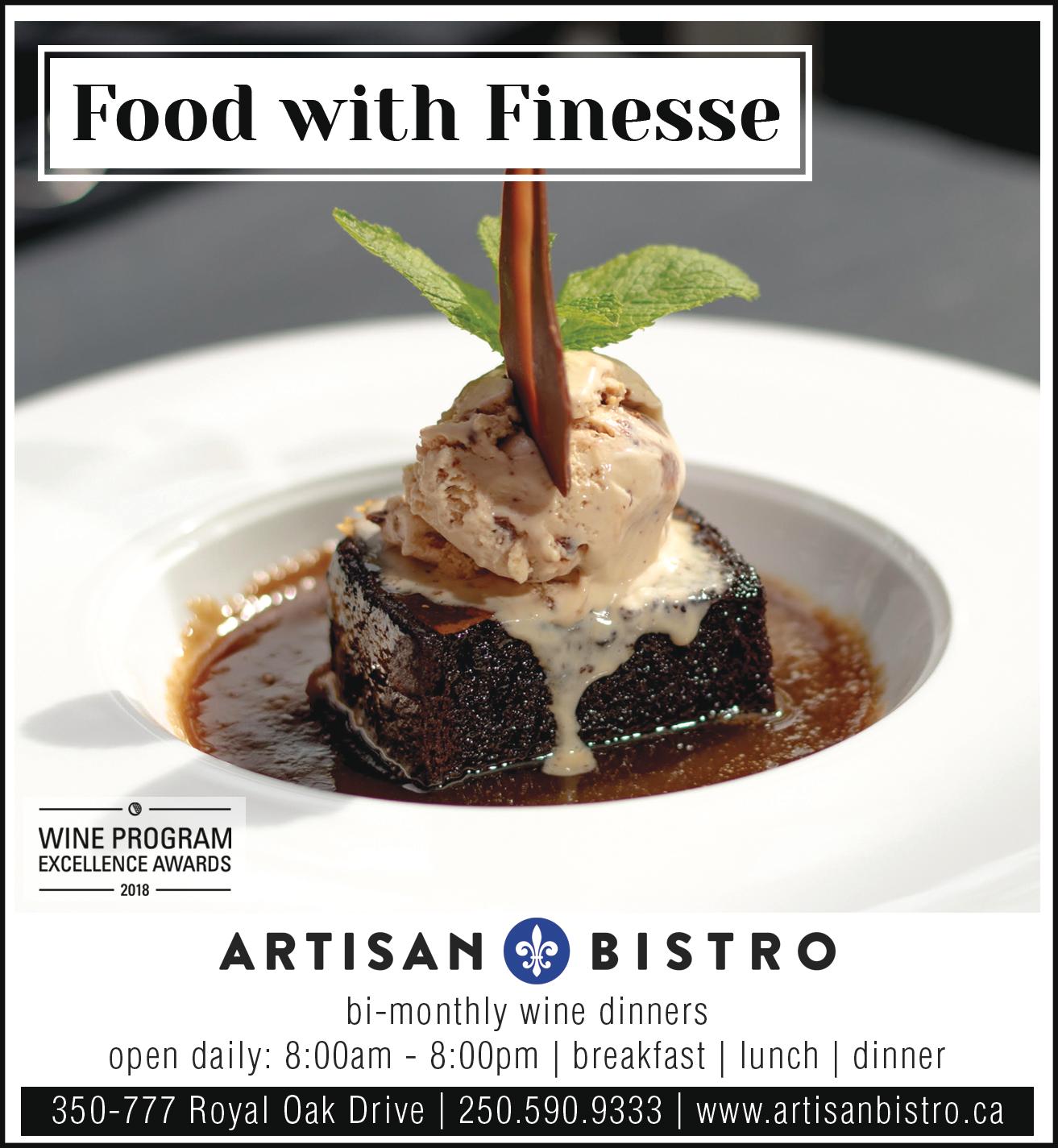
These bars offer more than just nutritional value. Each and every one is lovingly handmade in community bakeries throughout Nova Scotia by people who face barriers to employment. So when you bite into one of these tasty gems, you’re supporting a good cause, in addition to fuelling your body with valuable nutrition. Made with heart-healthy oats, Real Food Bars also contain a bevy of nuts, fruits, and good-for-you fats. I tried both the Coconut-inthe-Dark variety and the Blueberry Grunt. While I enjoyed both immensely, I found the latter absolutely addictive. It contains a mouth-watering list of superfoods such as oats, almond butter, dried blueberries, walnuts, and honey. That’s real food indeed. (Available at Thrifty’s and Bulk Barn.)
Good To Go
One of the newest entries to hit the Canadian market, Good To Go bars are keto- and vegan-friendly low-carb bars suitable for a variety of dietary choices. Containing a mere 2 mg of sugar and 160-170 calories per bar, they are surprisingly delicious. Created in Ontario by three health-conscious siblings, the bars are non-GMO certified, gluten-free, and chockful of health-enhancing ingredients like almond and amaranth flours. What makes these flours so impressive, you ask? Both are rich sources of calcium, magnesium, iron, and vitamin E as well as cancer-fighting antioxidants. While the bars are available in a variety of appealing flavours, my personal favourite is the Raspberry-Lemon. But don’t let me influence your choice; try them yourself! (Available at London Drugs and Thrifty’s.)
Handmade Ethical Local Traditional CURED AND SMOKED MEATS 2032 OAK BAY AVENUE, VICTORIA 250.590.PORK THEWHOLEBEAST.CA CURED@THEWHOLEBEAST.CA
PAM DURKIN 12 JANUARY/FEBRUARY 2020
REPORTER
Bunny’s Nook Kitchen

Little Jumbo
WORDS
PHOTOGRAPHY
Gillie Easdon
Daniel Murphy
Sherri Martin
Jacqueline Downey
13
Wakakozake Cocktail at Little Jumbo JACQUELINE DOWNEY
The Dream Café
There’s nothing quite like Bunny’s Nook Kitchen in Esquimalt.
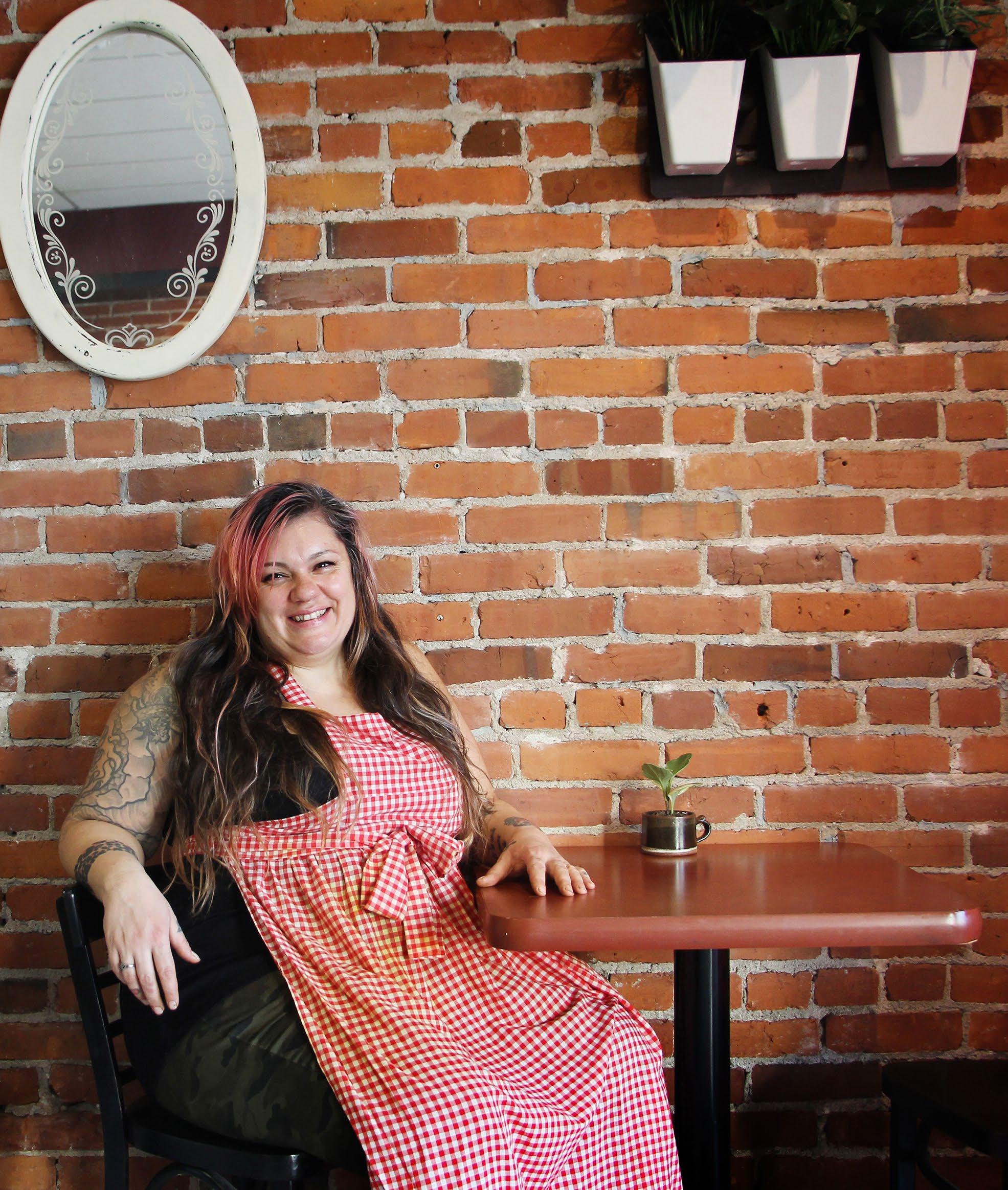
I’ve never been a fan of anything cheesecake or vegan. Bunny’s Nook Kitchen changed my mind.
“Try this cashew lime cheesecake bite,” says Jenny Smart, handing me a small square. She exudes a particular sincerity and warmth that makes me want to sample her food, whatever it is. The sharp bite of the lime balanced with the thick, sweet cashew and the just-right crust— it was exquisite.
Bunny’s Nook Kitchen opened early November 2019 in Esquimalt, serving breakfast, lunch, and a tasty array of baked, mostly gluten-friendly, maple syrup-sweetened, and vegan fare. The first meal I enjoyed in her casual and welcoming space was the Vegan Breaky Bowl. I figured if she could completely overturn my life story about cheesecake, she was probably onto a few other things. Plus, as I mentioned, something is compelling about Jenny—her kindness? Openness? Talent?
The Vegan Breaky Bowl has oven-roasted potatoes with sautéed vegetables, Very Good Butcher savoury sausage, tofu drizzled with a vegan cashew hollandaise with just the right lemon brightness, and kale pesto. The pesto includes nutritional yeast—it is salty, smooth, and yummy. Paired with a drip Caffe Fantastico? That’s a good morning, any day of the week.

I’ve been in three times since Bunny’s Kitchen opened. It’s always lively. “I thought I’d just have a quiet start to my little café,” Smart admits. Her life plan had not included being a café owner and operator. She grew up in an unstable family of five, where dinner was a box of Kraft Dinner, some hamburger patties, and a can of corn. “I didn’t expect much from my life. We were very poor.” As a kid, she was part of the Big Brothers & Sisters program. Her Big Sister Audrey taught her how to bake, roller skate, and swim. This was pivotal. Smart left home at 14 and at 18 started working in pubs. Whenever she liked something, she would figure out how to make it at home. Curious, attentive, and with an evident love of delicious, simple cooking, all of this is reflected in the food and feel you’ll enjoy at Bunny’s Kitchen. The menu is two-thirds vegan and one third not vegan at all. Hello Triple Garlic Turkey Burger, Chicken Tacos, Breakfast Sandwich, and more. “I want everyone to enjoy eating here. You’re a vegan? Great. You like your meat? Come on in.” And, wow, her Mocha Bars are solid, satisfying, and decadent, the Lavender Lemon Bars are luscious with a zing, and the vegan Chocolate Orange Cheesecake is a showstopper. Smart’s “Let’s just all eat together” attitude is refreshing.
She played roller derby for six years, and that profound sense of community was really huge, she says. When she met her husband and had three children, she got more into healthy food. But a derby accident, motherhood, and also having a stressful and sedentary job at Peers Victoria lead to dramatic weight gain. She explored sugar-free eating. She also participated in Peers Victoria’s small business program and gives profound credit to her husband and everyone at Peers Victoria, including Julie, the program facilitator and her mentor, for giving her the support and knowledge to launch Bunny’s Nook Kitchen.
“I didn’t get any nutrients as a kid, so I’m making up for it. I eat the garnish off the chicken wings plates when I go out for a bite with friends,” she laughs. Her original idea was to have a kid’s café, somewhere parents could have excellent food and also be comfortable taking their kids. She was attending Strong Start with one of her children at George Jay Elementary, and other parents were floored that Jenny took her kids to restaurants regularly.
BUNNY’S NOOK KITCHEN 904 B ESQUIMALT RD. 250-361-9346
Oven roasted potatoes topped with sautéed veggies, a choice of Red Barn sausage or Very Good Butcher sausage, free run eggs, tofu drizzled with vegan hollandaise and kale pesto.
Jenny Smart, Owner Bunny’s Kitchen
SHERRI MARTIN
14 JANUARY/FEBRUARY 2020
SHERRI MARTIN
want everyone to enjoy eating here.
Great.






Her mother, who has since died, was a heavy drinker. She got sick, quit drinking, and finally started eating vegetables. “I got my mom back, we had four great years.” Smart’s mom would encourage her to cook big family dinners. She also kept repeating, “You just need this cute little cafe.”

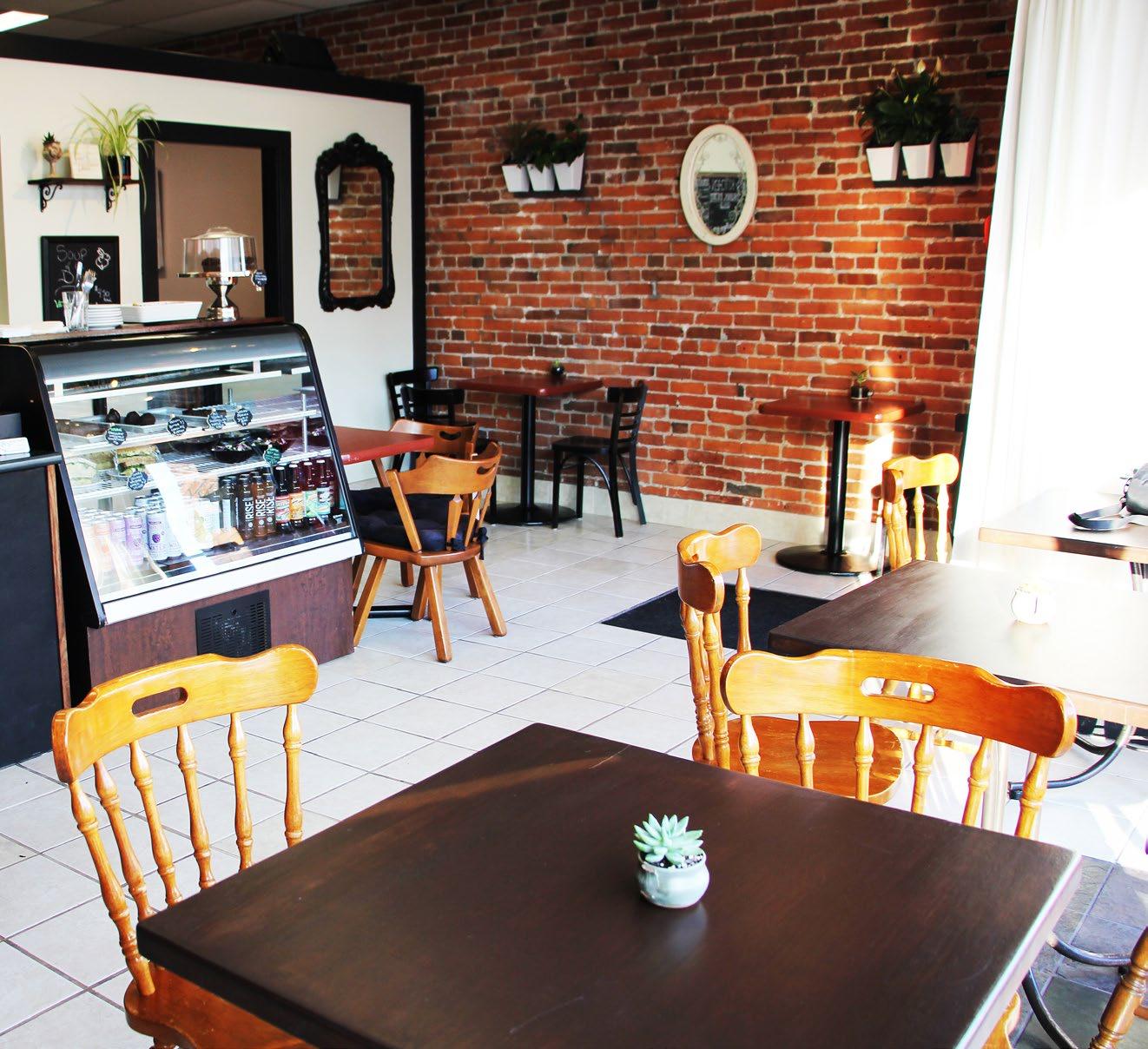
There’s nothing quite like Bunny’s Nook Kitchen, and the response has been overwhelming. Smart, too, has been floored. “It still doesn’t feel real.” Down the line Bunny’s Kitchen will host some evening events as well.

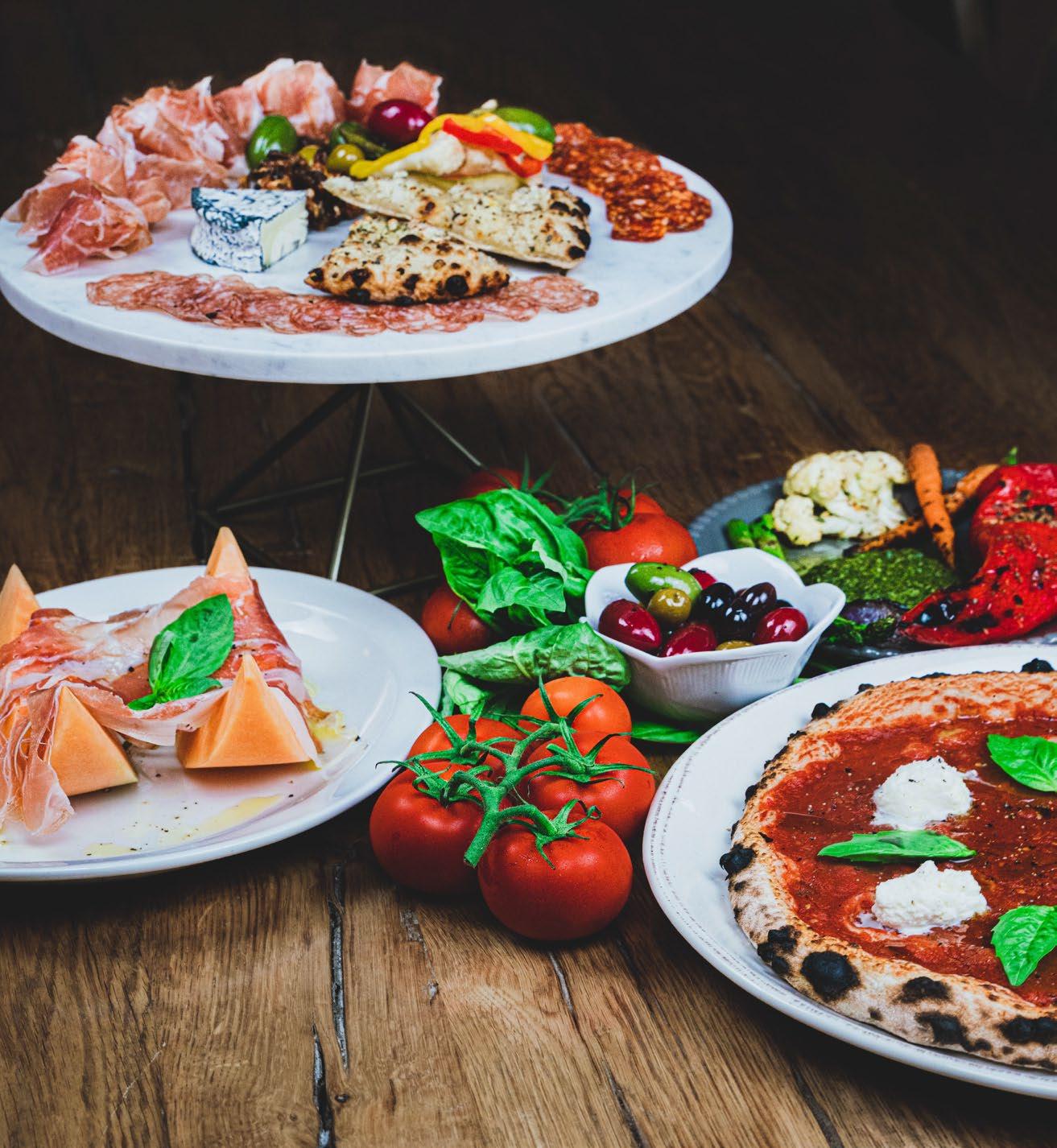
She made a point of reaching out to share a vital piece of the Bunny’s Kitchen story. As a person who has always struggled with self-confidence, she wasn’t sure she should give it a go. Could she do it? Was she good enough? One summer day, floating on a local lake, her safe space for meditation and a little solace, she said to herself, “If I’m meant to open this café, a dragonfly will land on my nose.” A dragonfly landed on her nose. “Did you see that?” she asked a friend, who witnessed as Jenny Smart, once again, asked for a dragonfly to land on her nose if it was meant to be. “And I’m not kidding, a dragonfly landed on my nose, another on my toe, another on my leg and more. I looked around to see if this was happening to everyone. It couldn’t be just be happening to me ... it was only happening to me.”
GILLIE EASDON

DOWN THE HALL, 506 FORT ST. / WWW.LITTLEJUMBO.CA / 778.433.5535 This winter, discover a new wave of fine wine. JumboAdV04(eat).indd 1 2019-12-05 4:59 PM Kyle Miner Photography. Simply Italian. 9000 WOOD-FIRED PIZZERIA 2401 Millstream Rd. | 250 590 4493 | 900-degrees.ca
“I
You’re a vegan?
You like your meat? Come on in.”
—JENNY SMART
15
SHERRI MARTIN
LET’S
CATCH UP:
Little Jumbo at (almost) Seven
A heartwarming tale of sustained success in a volatile industry.
THERE’S NO ARGUING THAT Victoria punches above its weight in terms of its hospitality offerings, and perhaps no establishment has added more to its pugilistic repertoire than Little Jumbo.
For almost seven years it has held firm as a dim, secretive speakeasy at the end of a fluorescent, gaudy hallway—the inverse of a light at the end of the tunnel—tucked just far enough out of the way to evoke an air of mystery and intrigue; of escape from our everyday rigours.
While seven might be an eternity in Victoria’s high-turnover, heavily seasonal hospitality world, Jumbo has survived while undergoing relatively little change—at least on the surface.
Upon joining the local bar scene in 2013, Jumbo instantly took a place on the cocktail podium alongside other relative newcomers Clive’s and Veneto. And it has stayed there ever since. A visit today is no different, in many ways, than when it first opened its doors: the same balance of consistency and innovation; the same professionalism and speedy execution in peak service; the same sense of authenticity in a field that so easily sways into posturing and contrived “cool.”

But behind the unchanging veneer of the Jumbo experience is a concerted effort, on multiple fronts, to consistently elevate the quality of their customer’s experience ever higher—regardless of a steady stream of accolades and applause, telling the Jumbo team that everything they are doing is “good enough.”
That consistent high-achievement is even more remarkable considering the local state of the industry. Combine the high-turnover nature of hospitality in general, with Victoria’s low reserves of capable, available staff, and you’ve got a staffing nightmare that most restaurateurs know all too well.
But owner Bruce Gillespie, who built his career as a high-level management consultant, recognizes that Jumbo’s internal workings are slightly different from the norm: “We have more stability in our team than is usual, in this current landscape.” And what does he attribute that to? “Employee engagement. If we’ve managed to stay ‘fresh’—which I believe we have—it’s because of an open culture of ideas,” he muses.
Little Jumbo’s director, Kyle Guilfoyle, agrees: “We’re all about collaboration. It’s one thing for a leader or manager to tell a team to act out their idea. But when we’re all contributing and collaborating, we’re all driven to do more.”
Despite the inclusive nature of the staff culture, Jumbo is still just as susceptible to disruption as anywhere else. In late 2019, executive chef Gabriel Fayerman-Hansen amicably parted ways with the kitchen to extend his pursuits in farming. Rather than take the loss as a negative, the Jumbo team saw an opportunity to step up and innovate.
“We interviewed for a straight replacement,” admits Gillespie, “but two chefs from our own team approached me with a different idea.” That idea was a “co-head chef” model.

LITTLE JUMBO DOWN THE HALL, 506 FORT STREET 1.778.433.5535 | LITTLEJUMBO.CA
JACQUELINE DOWNEY
JACQUELINE DOWNEY
“When we’re all contributing and collaborating, we’re all driven to do more.”
—KYLE GUILFOYLE
Co-Chefs Conor Berg and Jesse Wilson
16 JANUARY/FEBRUARY 2020
Bartender Sebastian Lopez
“Operationally, it’s very complementary. On one hand we’re seasoned, the other, creative. It’s like having perfect Siamese twins in the kitchen,” he laughs. Those “twins” are Jesse Wilson and Connor Berg, who have already gleaned years of experience from the Jumbo kitchen—and its culture.
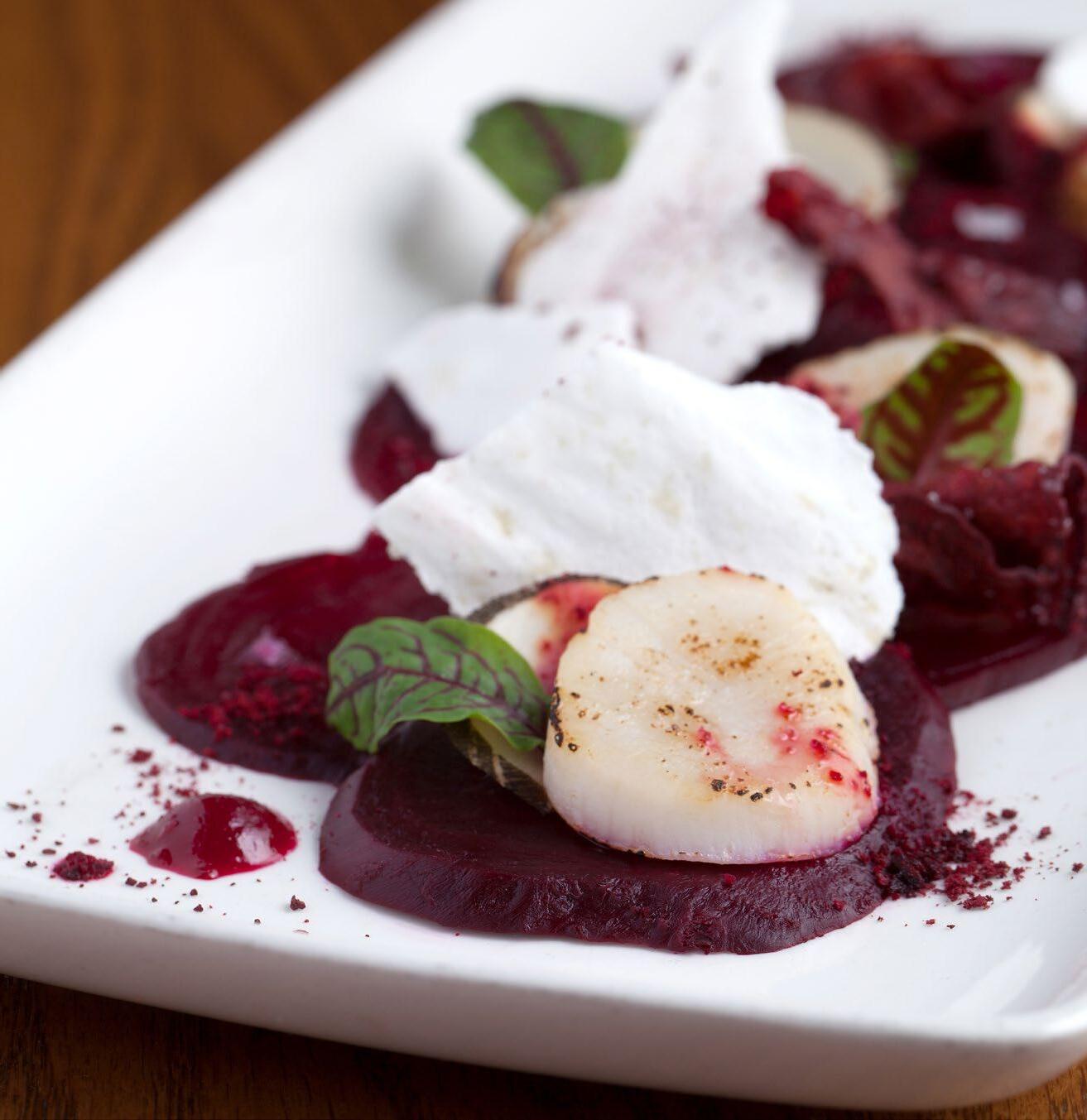
How has this change affected the direction of the menu? “We’re still staying true to ourselves,” says Gillespie. Then how would he describe Jumbo’s culinary direction in general? “Well, I usually describe it as really, really good! But for ‘foodies’ it’s French technique, contemporary creative, always using the very best ingredients.” Guilfoyle adds: “I’d describe it as PNW (Pacific North West) with global influences: Japanese, Spanish, eastern Mediterranean.”





Of the three wheels on Jumbo’s “tricycle” (cocktails, food, wine), much attention has been paid over the last couple of years to raising the bar for their food offerings. While their team would be the first to admit that there is always room for improvement, there’s a sense that the “heavy lifting” for the food program has been accomplished, and now the focus of the team is directed squarely towards the wine menu.
“We’re really working to upscale it,” says Gillespie. Again, staff input has been critical. Blind tastings have revealed pleasant surprises. And while there will always be a place for the BC wines that speak of our region, there’s now more room for international contributions. When asked about the direction of the wine list, Guilfoyle adds that “it’s another step towards integrating everything: wine complements food; cocktails complement ambience; ambience complements human interaction—which of course is improved with great wine, food, and cocktails. It all has to fit together.”

Perhaps that’s the secret of Little Jumbo’s endurance: in a town where so many establishments are trying to be “everything to everyone,” they’ve so clearly defined their identity that they can now hone in mercilessly on refining every detail. It’s the alternative to resting on one’s laurels, a pastime that just doesn’t fit with either Gillespie or Guilfoyle’s personalities. Asked how Jumbo stays so consistently at the top of every local ranking, Gillespie asks: “We’re number one? Where? And for what, exactly? I love Victoria, but even if we were somehow the best in our field here, that’s simply not enough.”





So, where do you go to benchmark against the elites of the global hospitality industry? Somewhat universally, New York City comes to mind. Gillespie recently flew there specifically to rate Jumbo against “eight of the top 30 bars in North America”—by popular opinion—in terms of cocktails, ambience, and food. “On some points we graded out really well, on others …we still have work to do. But that’s the point.”
And so we circle back to that recurring drive for continual improvement; acknowledging their organization’s strengths and weaknesses, and addressing them honestly, driving the details towards the highest standard imaginable—no matter how arbitrary they might appear to outsiders (Gillespie: “Things like ice. Sounds weird. But that’s something we can lead on”).

If it’s been a while “between drinks” at Little Jumbo, it’s well worth traversing their short, well-illuminated corridor for a refresher—both literally and figuratively. They roll out a brand-new cocktail list eight times a year, which keeps things “spicy” if you’re looking for something new to add to your arsenal of old favourites. And their evolving food menu now reflects the complementary influences of their co-head chef tandem. Their real recipe for success, however, remains the same as it ever was: treat every detail with meticulous importance, and seek improvement through the passion and skills of a dedicated team.
DANIEL MURPHY





JACQUELINE DOWNEY Beet & Scallop Carpaccio 17
Want to make a difference and still meet your financial goals? Let us show you how using proactive Environmental, Social and Corporate Governance (ESG) standards can do just that. We’ve been doing it for years. Right here in Victoria.
www.blueherongroup.ca




250 361-2284 | blueheronadvisorygroup@cibc.ca


Neil Chappell and Graham Isenegger are Investment Advisors and Portfolio Managers with the Blue Heron Advisory Group of CIBC Wood Gundy in Victoria BC. CIBC Wood Gundy is a division of CIBC World Markets Inc., a subsidiary of CIBC and a Member of the Canadian Investor Protection Fund and Investment Industry Regulatory Organization of Canada. CIBC Private Wealth Management consists of services provided by CIBC and certain of its subsidiaries, including CIBC Wood Gundy, a division of CIBC World Markets Inc. “CIBC Private Wealth Management” is a registered trademark of CIBC, used under license. “Wood Gundy” is a registered trademark of CIBC World Markets Inc. If you are currently a CIBC Wood Gundy client, please contact your Investment Advisor. Past performance may not be repeated and is not indicative of future results.

Contact us today to learn how we help create more sustainable portfolios.
FRESH RIGHT HERE ON VANCOUVER ISLAND. SUSTAINABLE, ENVIRONMENTALLY FRIENDLY INVESTMENT SOLUTIONS 106 Superior Street | 250.380.0088 | IlCovoTrattoria.ca ENJOY A TASTE OF ITALY Dinner ~ Mon to Sun from 5pm Cucina Italiana 18 JANUARY/FEBRUARY 2020
SERVED
Comfort in a Bowl
Few foods are as reassuring as homemade pasta. Tender and yielding, fresh pasta is comfort in a bowl.
RECIPE + TEXT
Denise Marchessault
STYLING + PHOTOGRAPHY
Deb Garlick
Ifirst made fresh pasta at culinary school. Our instructors maintained that pasta tastes best when made with a rolling pin (the theory being that the grain of a wooden pin imprints subtle indentations in the pasta, thereby allowing more sauce to stick). So we rolled our dough with wooden dowels until our arms ached. These days, pasta-making is painless and deeply satisfying. Most cooks today rely on a hand-crank pasta machine that clamps to the counter or a standup mixer fitted with a pasta attachment.
There are no hard and fast rules when it comes to pasta dough. Flour, eggs, salt, and water (and sometimes oil) come together easily in a straightforward dough. And like most simple recipes, the variations are endless. Some cooks, for example, prefer yolks to whole eggs for a richer dough, while others opt for a finely milled “00” Italian flour, rather than all-purpose, for a silkier dough. Some insist the flour and egg be mixed directly on a countertop, others prefer to use a bowl. Whatever the technique or formula you use, homemade outshines store-bought fresh every time.
Once the dough comes together it is kneaded, a tactile pleasure that teases out the day’s stress. Rolling the dough into long sheets of silky pasta is a mindful practice and, if you take the time, you’ll enjoy the process nearly as much as the result.
Transforming the dough into soft pillows of ravioli is my idea of fun—and easier than you might think. Pasta can be stuffed with just about any filling, but if you’re a mushroom lover, you’ll fall hard for these savoury ravioli. Stuffed with fresh and rehydrated wild mushrooms, herbs, and cheese, these ravioli are irresistible. And the sauce lends intense flavour, thanks to the mushroom stock (the liquid used to soak the dehydrated mushrooms).
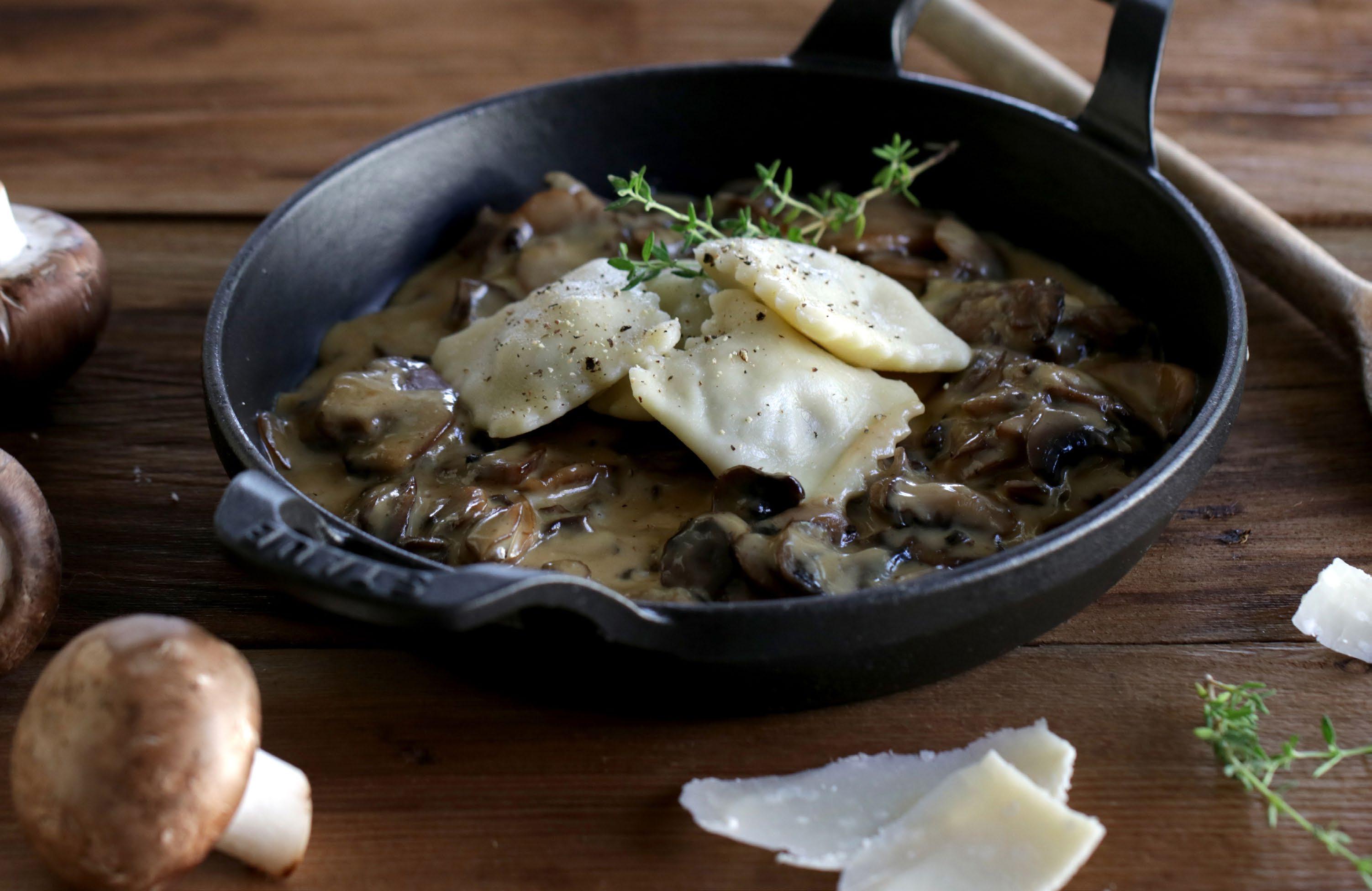
The ravioli recipe yields just enough leftover dough to re-roll and fashion into fettuccine ribbons, which are delicious tossed in a simple nutty herb pesto. (The ravioli is also lovely with the pesto.)
The beauty of fresh pasta, besides its exceptional taste and texture, is that it can be prepared a day or two in advance. The sauce and pesto can also be made ahead of time, making fresh pasta ideal for company.
Here are a few pasta tips to keep in mind:
• Season the pasta water generously with salt: about 1 Tbsp kosher salt (or 2 tsp table salt) per litre of water.
• Fresh pasta cooks quickly, 2-3 minutes; have the sauce warm and ready.
• Do not rinse pasta; the starch helps the sauce to cling.
• Save a bit of pasta water to thin your sauce or pesto; this also helps the sauce to cling.
• Heat serving bowls to keep the pasta warm.
• To prepare pasta in advance: toss precooked pasta with a bit of oil, cover, and refrigerate overnight. Briefly reheat pasta, about 30 seconds, in boiling water.
• To freeze: Place (uncooked) ravioli on parchment-lined baking tray in a single layer, with room between each. Once solid, transfer to freezer bags. Boil directly from frozen.
Masterclass
19
M u s h room ravioli in a rich mushroom & wine sauce
Fresh Pasta for Ravioli
Makes about 48 ravioli, about four servings (or six to eight appetizer servings).
The pasta dough requires an hour resting period, during which time you can prepare the filling and sauce.
2 whole eggs
2 egg yolks
1 Tbsp oil
2 Tbsp water
3/4 tsp kosher salt
1¾ cup flour
Special equipment:
Pasta machine (a rolling pin works, too)
2½-inch ravioli stamp
In a small bowl or cup, mix together the eggs, yolks, oil, and water. In a large bowl, combine the salt and flour. Pour the egg mixture over the flour and mix with a fork, gathering up the flour until the mixture forms a ragged dough. If necessary, add additional water, by the teaspoonful, to incorporate all the flour.
Transfer the dough onto a flour-dusted work surface and knead for a minute or two until smooth. Cover with plastic wrap and refrigerate for one hour.
Cut the dough into four equal pieces. Working with one portion at a time (cover the remaining), and using a rolling pin, flatten the dough thin enough to fit the dough through the pasta machine’s widest setting.
Dust each portion of pasta with flour on both sides and feed it through the machine’s rollers at its widest setting. Fold the pasta in half, dust with more flour, and repeat. Gradually narrow the rollers after each feed, flouring as necessary to prevent sticking, until the pasta is smooth and thin, about ⅛ inch thick. Repeat with the balance of the dough, covering the dough with plastic wrap or a tea towel to prevent it from drying out.
Note: If not using a pasta machine, use a rolling pin to flatten the dough into long strips about 6 inches wide and ⅛ inch thick.
Before assembling the ravioli, it helps to first visualize the process: a strip of pasta will be dotted with the filling, at equal intervals, then covered with another strip of pasta and cut and sealed with a ravioli stamp.
Place a strip of fresh pasta dough on a floured work surface. To help guide the filling onto the pasta, create a target by marking a very light impression of the ravioli stamp onto the pasta strip, in equal intervals, without cutting into the dough. Place onto the centre of each target a nugget of mushroom filling, about half a teaspoon. Cover with another sheet of pasta and stamp out the lumps of filling with the ravioli stamp.
Repeat with the remaining pasta. Save and re-roll any leftover trim for fettuccine ribbons (instructions below).
Place the filled ravioli onto a parchment-lined surface dusted with flour and cover with plastic wrap.

If serving immediately, toss the fresh ravioli into a large 6-quart pot of rapidly boiling, generously salted water for a minute or two. Carefully remove the pasta with a slotted spoon and transfer to the heated mushroom sauce. Thin the sauce as necessary with a bit of pasta water.
Serve on warmed plates.
To make fettuccine ribbons: Gather the leftover dough and roll out into long strips ⅛ inch thick by 6 inches wide. Dust the strips generously with flour and fold the dough over, every six inches or so accordion fashion. Using a sharp knife, cut into strips about ¾ inches wide. Alternatively, if your pasta maker comes with a fettuccine attachment, feed the strips of dough (1/8” thick x 6” wide x 12” long) through the attachment, for perfectly uniform fettuccine. Delicious tossed with Spinach and Herb Pesto. For recipe, visit eatmagazine ca /spinachandherbpesto
If not using immediately, fettuccine pasta can dry for an hour or more on parchment paper dusted with flour or draped over racks or chair rungs that are protected with parchment paper.
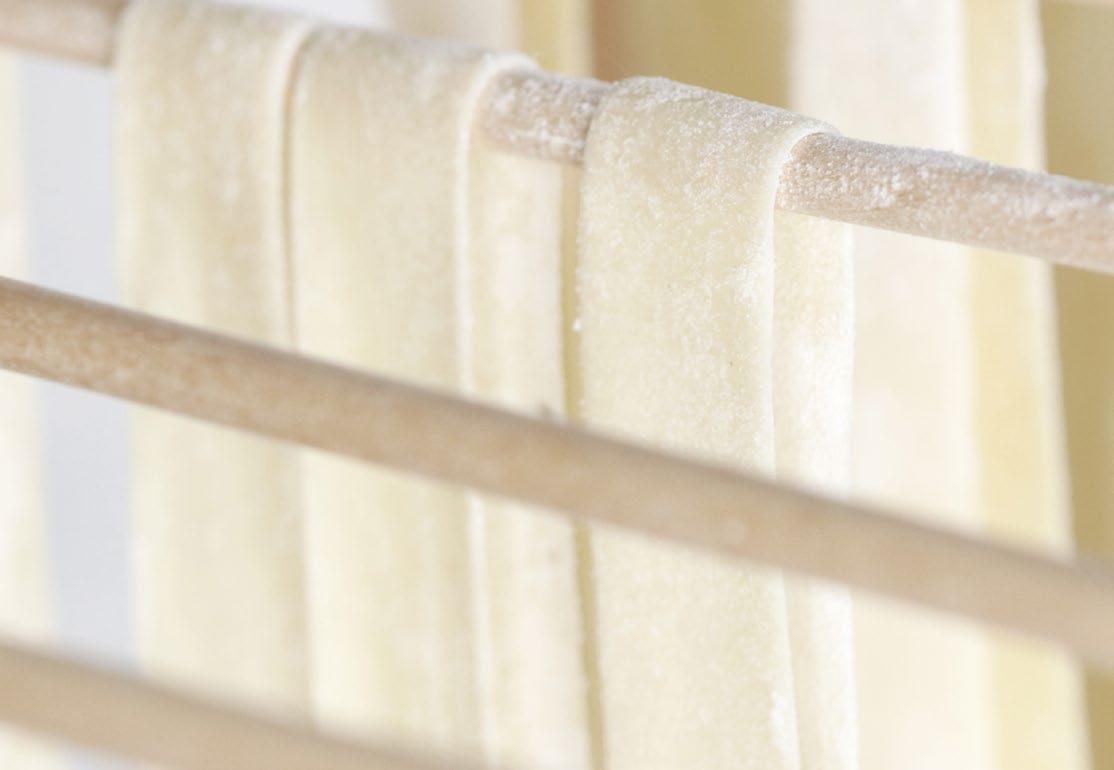
Fashion into little nests and dust with flour to prevent sticking. Store pasta between sheets of parchment in plastic freezer bags. Refrigerate for up to one day or freeze for up to 2 weeks. Frozen pasta needs no thawing, but it will take about a minute or two longer to cook.
Mushroom Ravioli
Mushroom Filling
You’ll need to chop the ingredients finely, otherwise they won’t fit neatly into the ravioli pockets.
1 oz (28 g) dried assorted wild mushrooms such as chanterelle, porcini, black trumpet, cauliflower, pine and lobster mushrooms (often sold in ½ ounce packets)
2 Tbsp vegetable oil
¾ cup finely diced shallots, about 2 shallots
Kosher salt
2 garlic cloves, finely chopped
3 cups finely chopped cleaned crimini or white button mushrooms, about ¾ pound
Zest from one washed lemon
1 Tbsp freshly squeezed lemon juice
¼ cup freshly grated Reggiano Parmesan
¼ cup goat cheese
2 Tbsp freshly chopped thyme
1 Tbsp freshly chopped parsley
Place the dried mushrooms in a bowl or large measuring cup and cover with 2 cups boiling water.
In a large skillet, heat the vegetable oil. Add the shallots and ¼ teaspoon salt and cook over medium low heat, stirring occasionally, until softened and translucent, about 3 minutes. Add the garlic, stir
Fresh fettuccine
Ravioli stuffed with wild and fresh mushrooms
ribbons
20 JANUARY/FEBRUARY 2020
until aromatic, about 20 seconds. Add the chopped mushrooms, another ¼ teaspoon of salt, and cook for a few minutes or until the mushrooms are cooked through.
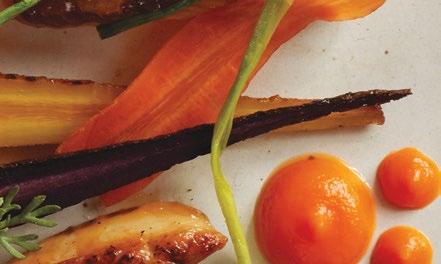
Remove the dried mushrooms from their soaking liquid (retain the liquid for the sauce) and chop them very finely. Discard any tough bits or stems. Add the rehydrated mushrooms to the cooked mushroom mixture and cook for about two minutes. Off heat, add the lemon zest, lemon juice, Parmesan, goat
cheese, and herbs. Mix to combine, then check the seasoning—the filling should be highly seasoned as the flavours become muted when encased in pasta. Add additional lemon juice or salt as necessary.

Cool the filling completely before filling the ravioli.
Mushroom Sauce

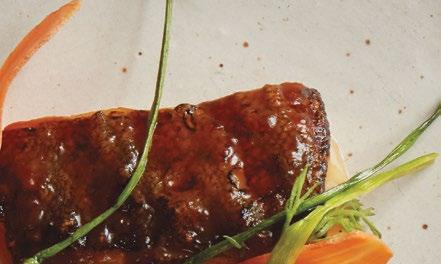
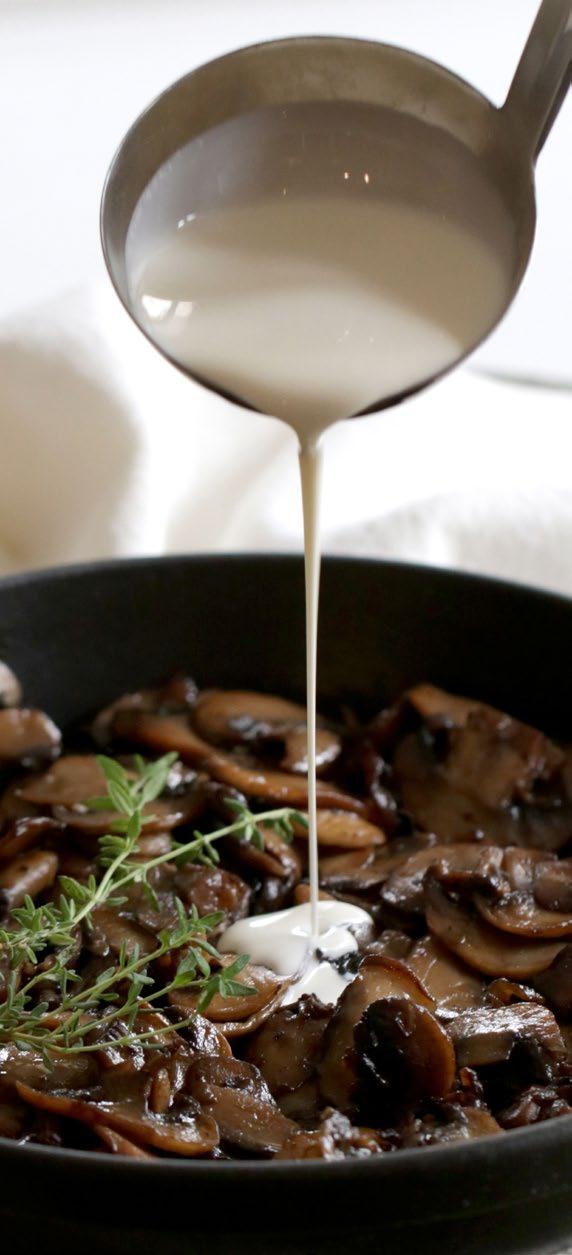
Mushroom liquid from the dried mushrooms
4 Tbsp vegetable oil, plus more as needed
3 cups sliced fresh mushrooms, about ¾ pounds


¾ cup dry white wine








1½ cups whipping cream

½ cup freshly grated Reggiano Parmesan


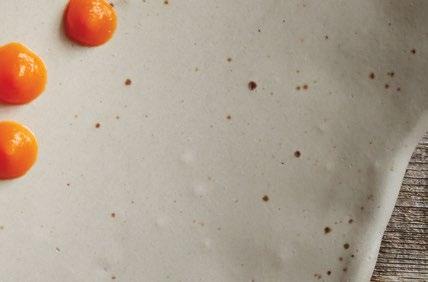








1 tsp freshly squeezed lemon juice
Optional garnishes

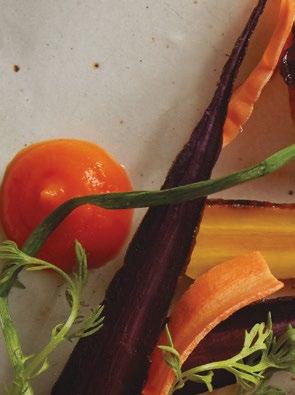
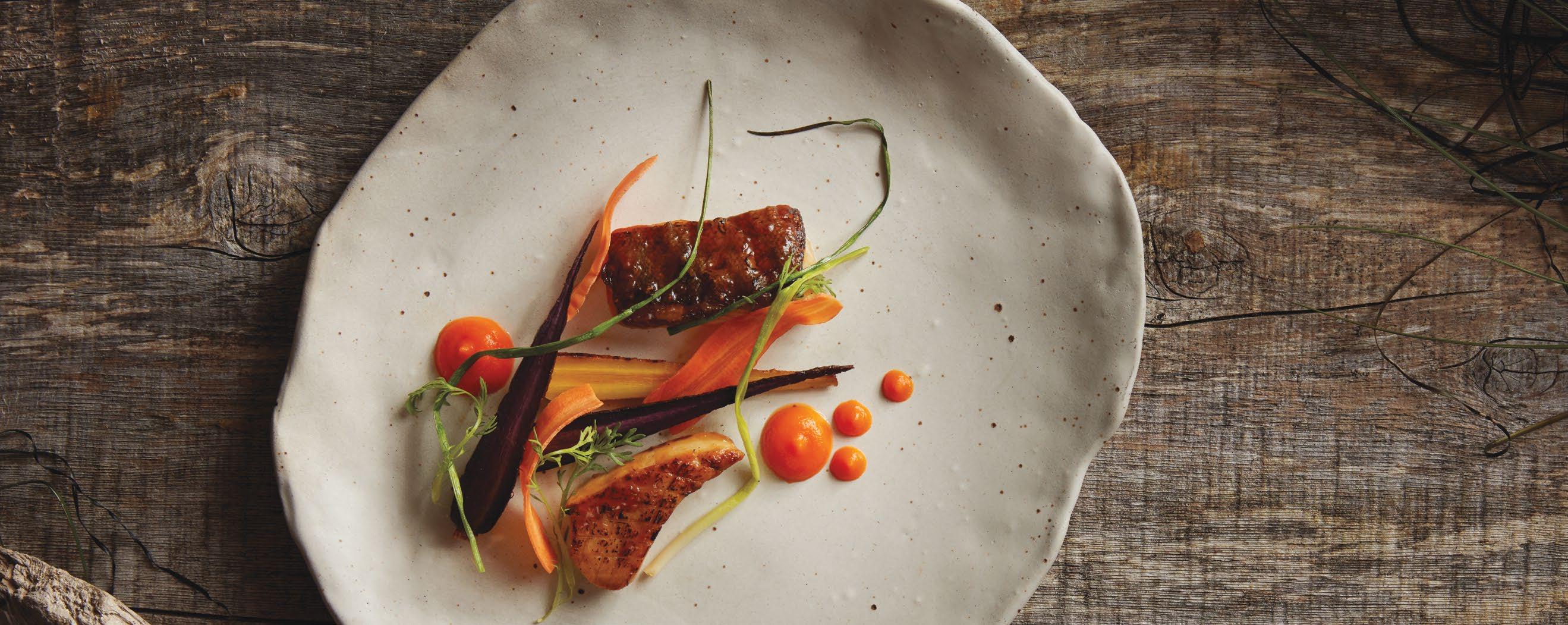
Freshly chopped parsley
Lemon zest


Freshly grated Parmesan cheese
Strain the mushroom liquid through a finemesh strainer lined with cheese cloth.
Heat the oil in a large skillet. Working in batches, so as not to crowd the pan, add the mushrooms in a single layer, add a pinch of salt, and cook over medium heat until lightly browned, shaking the pan once the mushrooms have had time to brown on one side. Repeat with the remaining batches, adding a pinch of salt to each batch.
Return the cooked mushrooms to the pan, increase the heat to medium high, and add the wine. Continue cooking until the wine has nearly evaporated. Add the strained mushroom liquid and continue cooking until the liquid has nearly evaporated. Add the cream and the cheese and continue to cook the mixture until the cream has reduced and thickened enough to lightly coat the back of a spoon.
Taste and adjust seasoning with additional salt and lemon juice as desired.

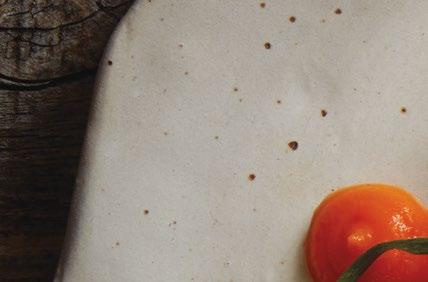

Add the warm ravioli to the mushroom sauce, coating the pasta with the sauce.
Making ravioli is deeply satisfying
Freshly grated black pepper




Serve in warmed shallow bowls and garnish with parsley, lemon, Parmesan and freshly ground pepper, if desired.

21
A luxurious drizzle of cream makes for a silky mushroom sauce
PASTA PERFECT
Pasta lies in a peculiar place in the larger culinary ethos. In Italy, it remains layered with tradition and rooted in a deep history. It is something sacred and not to be tampered with. But most of the pasta we know in North America hardly resembles that of its origins. Often, the carb-filled noodles we know and love are a wholly different beast from their European variety.
Yet while the pasta we’re familiar with may be entirely different from what you’d find in Rome, that doesn’t mean it can’t still be delicious. If you’re in search of the perfect noodle during these cold winter months, here are several Victoria restaurants that approach pasta from different angles.
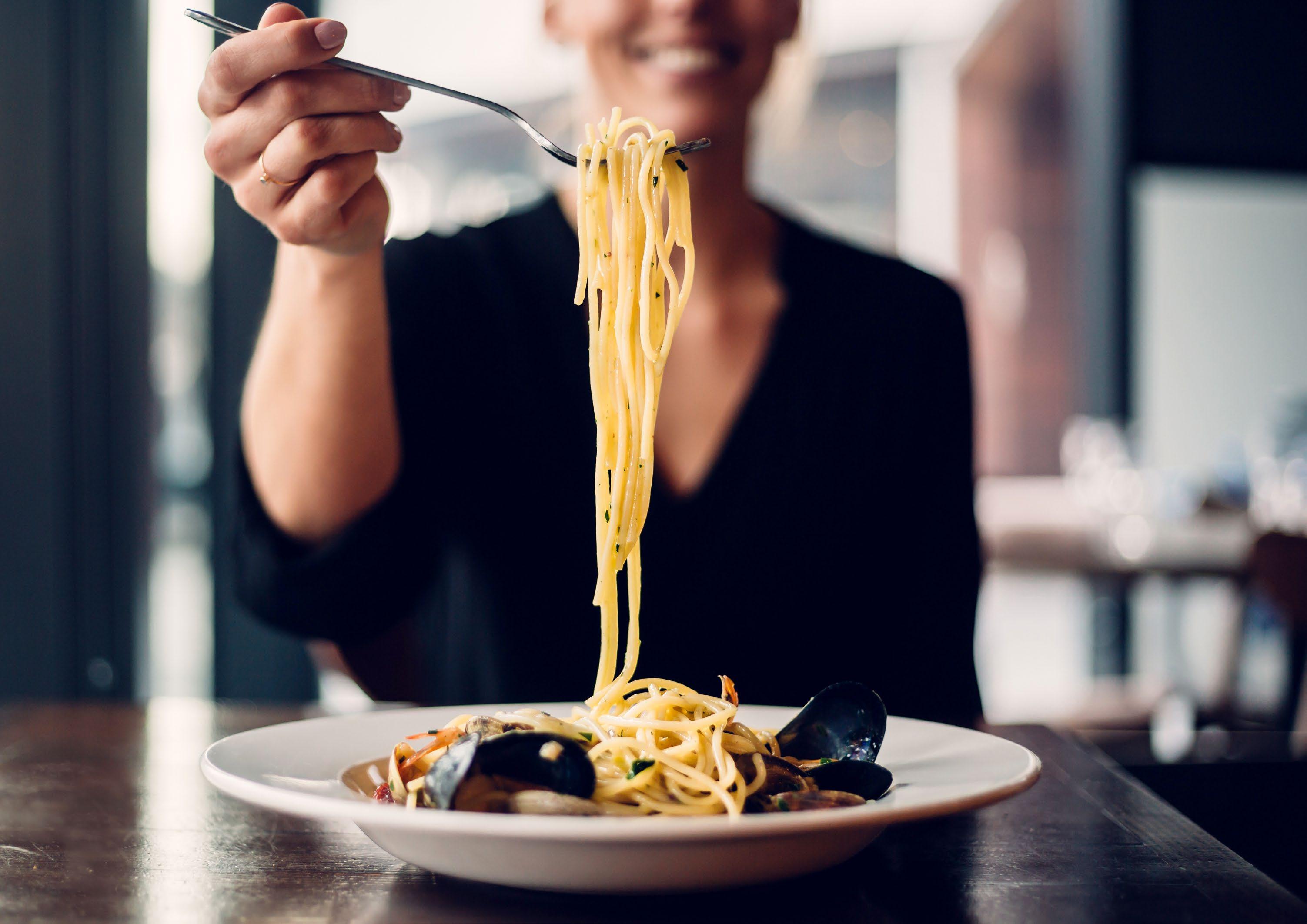 In search of the peerless noodle in Victoria’s Italian restaurants and European-style bistros.
WORDS
Adrian Paradis
PHOTOGRAPHY
Johann Vincent
In search of the peerless noodle in Victoria’s Italian restaurants and European-style bistros.
WORDS
Adrian Paradis
PHOTOGRAPHY
Johann Vincent
22 JANUARY/FEBRUARY 2020
Il Covo
Il Covo is about as traditionally Italian as you’ll find without getting on a plane. With its high ceilings and heavy wood rafters, the interior feels like a grand hall while the patio is more like a secret garden. Il Covo is a true hidden gem in James Bay.
The chef, Rafael Laouini, is from Umbria (about two hours outside of Rome) and imbues what he does with his traditional knowledge and pride. “We try to do something different than other Italian restaurants here,” he says. “I think we are the only restaurant in Victoria who makes traditional, authentic Italian cuisine.” They source most of their ingredients locally and work closely with suppliers like Finest at Sea and Italian Food Imports. There are about a dozen pasta dishes on the menu, and specials every day, but Laouini says if there is a classic recipe that you don’t see, they can usually make it for you.
While they have a lot of options in terms of shape and style, one of Laouini’s favourite pastas to work with is fregula, which originally came from Sardinia and is made by rubbing pasta dough between the fingers until small pellets begin to form. These are then toasted in the oven before being cooked.

Of the pastas Il Covo serves, their spaghetti allo scoglio is their most popular. “Scoglio is a seafood pasta with tomato sauce. Ours has clams, scallops, calamari, prawns, and chunks of fresh halibut.” Keeping to what he knows, Laouini says he doesn’t like to mix North American and Italian styles—you won’t see any chorizo sausage or a laundry list of ingredients in his pasta. “Italian food is very basic,” he says. “It’s usually only two or three ingredients. My favourite recipe is cacio e pepe. It’s just pecorino cheese and black pepper. You can add pancetta if you want, but then it becomes something different.”


Il Terrazzo
Il Terrazzo has been a staple in the Victoria food scene for more than 25 years. With its brick fireplace ambiance and private courtyard, the Johnson Street restaurant offers Italian food with a west coast twist. “Most of our pastas have something a little unusual or special about them,” says Deepo Ollek, assistant manager at Il Terrazzo. “Most of them are a twist on a classic. We’re still an Italian restaurant, but we like to incorporate other elements into our dishes as well.”
One of their more popular options, the Marco Polo, is a perfect example of this classic-twist style. Linguine with chicken and toasted cashews, mango, and basil in a lemon cream sauce, the Marco Polo sounds a bit unusual at first but is a constant crowd-pleaser. Ollek says the dish has been on the menu since the restaurant’s opening and likely won’t be taken off any time soon.
Changing their seasonal dishes often gives Il Terrazzo a bit of flexibility to play around with ingredients and experiment with flavours. “Everyone loves noodles,” says Ollek. “Pasta is always approachable. It can be very simple like a marinara, or rich and creamy with bacon like a carbonara. Because you can always find what you’re looking for in pasta, there is a lot of versatility there.”
Zambri’s
Zambri’s opened in 1999 as the rustic, casual Italian joint behind the Market on Yates. Today, in their new location in the Atrium they are part of a larger family of carbon-neutral restaurants that includes Big Wheel Burger. Peter Zambri, still the chef to this day, says most of the pastas on his menu are tried and true options. “When we do special dinners or events, we will get a little experimental, but for the most part we keep things simple.” Zambri says he tries to use as many local ingredients as possible while keeping things fresh.
“Our two main pastas as spaghetti aglio olio peperoncino (just olive oil, garlic, and spicy peppers), and our penne with peas and gorgonzola. I could never take those off the menu, but I wouldn’t want to because they are fresh and tasty, and not heavy. You could eat those every day if you wanted to.”
An important detail to making pasta that Zambri says often goes overlooked (besides heavily salting your water) is to be mindful that your pasta shape matches your sauce. If you have a dish with small vegetables, for instance, you want some kind of shell that can hold the whole dish together in one bite. Otherwise, you might end up with all your vegetables on the bottom of your plate when you’re done. “We usually come up with a pasta shape first, and then come up with a sauce that will go with it,” he says.
Zambri points out that pasta is loved for its versatility and convenience. “It’s great because you can feed a family of four with one package of pasta. People love it. It’s inexpensive, delicious, and easy to prepare. It takes no time at all and anyone can do it. Doing it well is a different story though.”
Trofie al Pesto e Burrata at Il Covo Capesante at Il Terrazzo
23
Spaghetti Frutti di Mare at Zambri’s
La Pasta
La Pasta is one of the newer additions to the Victoria Public Market. Maryanne Carmack, manager and co-owner (with chef Aaron Lawrence), says La Pasta is in a unique position as it serves restaurant-quality food to a mostly take-out crowd. “When people come in, they want something quick and simple, but good quality,” says Carmack. “We produce an amazing pasta dish within about 30 seconds.”
Making several of their own noodles in-house, Lawrence is creating amazing quality food at a blistering fast pace. “We make pasta fresh daily. It consists of two carefully selected ingredients: water and durum.” Having the option to eat with proper tableware in the comfortable atmosphere of the market is always available, but most of their diners opt for the convenience of fast take-out.
La Pasta’s menu has a beauty to its simplicity. You can choose the ever-changing daily special, or pick your noodle and a complementary sauce. While they offer suggested pairings, you can also mix and match if you so choose. The spaghetti carbonara, their most popular dish, is topped off with a farm-fresh egg that diners mix into the pasta creating a magical creaminess. La Pasta also makes an amazing, pillowy-soft gnocchi in-house every Wednesday. “Pasta is such a versatile and adaptable kitchen staple—you can keep it simple with just garlic, olive oil, and chilies, or elaborate with truffles and cream. It’s family-style eating at its best.”
Carmack says she lets the food speak for itself. “We’re not doing anything overly complicated. We’re using simple ingredients because it’s part of our philosophy that simple is best. Our pesto is bright green, almost florescent, because we make it so fresh. We really try and highlight that simple freshness and we think our customers can taste that.”
Other Places to Get Your Pasta Fix!*
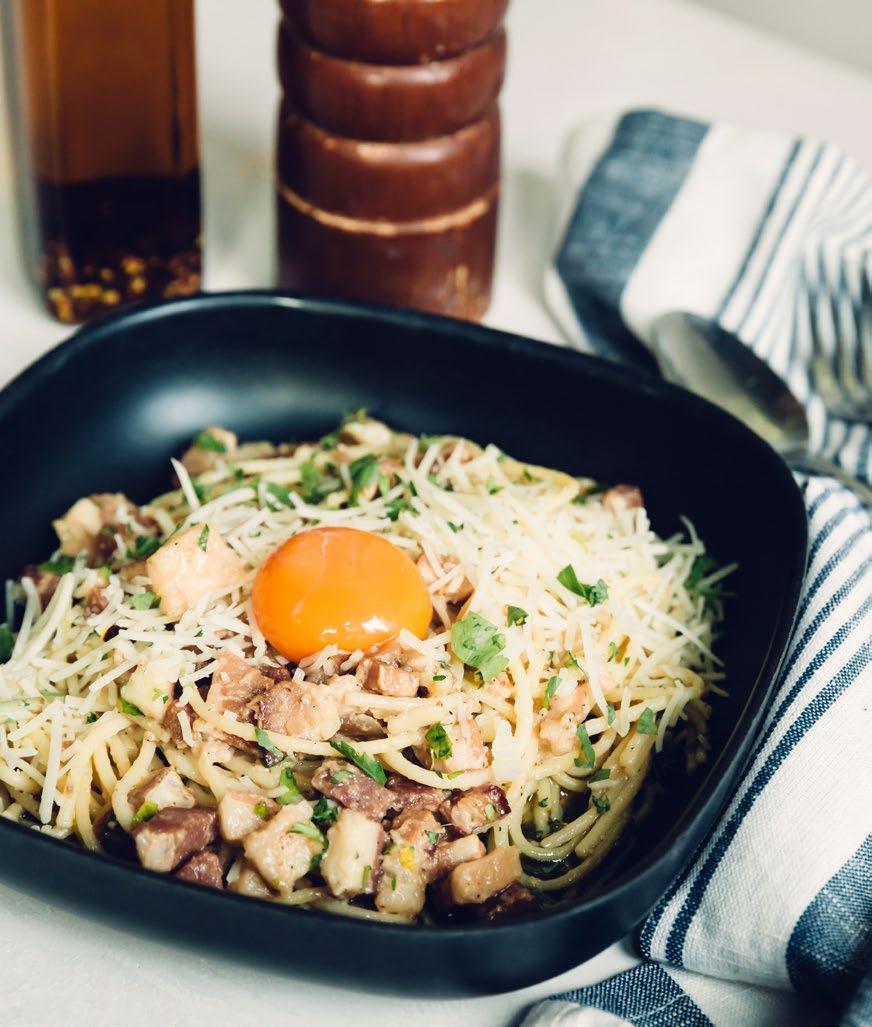
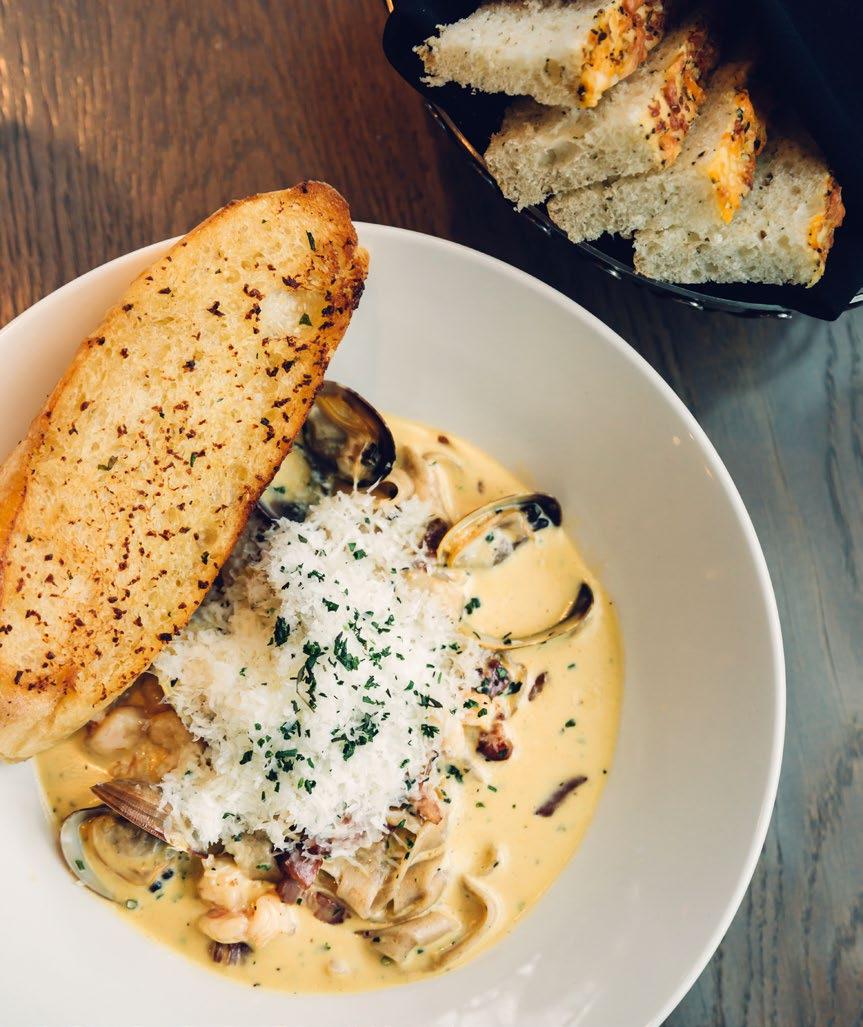
900° Wood-Fired Pizzeria in Millstream Village shopping centre recently started serving pasta, and it’s definitely worth it. Changing daily, see specials board for the day's pasta.
Lot 1 Pasta Bar on Cloverdale Avenue has an extensive pasta menu. They are making “Italian food for the modern age.”
Fiamo Pizza and Wine Bar is another downtown Victoria staple. In addition to their extensive pasta offerings, their menu has influences from France, Spain, and the Mediterranean.
Artisan Bistro
Daryl Pope, chef and owner at Artisan Bistro in Broadmead Village, is the former chef at the Hotel Grand Pacific. While there, he often made all his own pasta so he got used to the process. “We make all our ravioli and tortellini fresh, but I will also pull from Vancouver Island Pasta Company because we will sell so much,” he says. “I don’t have the production kitchen to make that much pasta.”
Having only a few pasta options on his menu at a time, Pope changes his dishes up regularly with the season. His winter menu includes a braised beef ragu with wild mushrooms and pecorino cheese. Having a background in French cooking, Pope says he tends towards rich sauces and showcasing ingredients. “I try to make things that other people won’t have on their menus,” he says. “We currently make a maple chicken pasta with almond butter and asparagus. It’s a different blend, but people love it.”
He says his secret for making great pasta dishes is to start with the best ingredients. He gets all his produce locally and uses fresh pasta because of its superior texture and cooking time. “It cooks in about a minute,” he says. “Dried stuff will take five to eight.”
Depending on whom you ask, pasta involves an endless search for authenticity and simplicity, or it is a starchy vessel for creativity and expression. Paradoxically, it is both of these things. In North America, with that lack of history and tradition, pasta has perhaps lost some of its identity, but that loss brings a freedom from constraint with it. No longer bound by tradition, pasta is free to become something else entirely. Regardless of where you get it, pasta will almost certainly be the perfect comfort food.
Pagliacci’s has been a boisterous, crowded, neighbourhood place, known for their pasta for the past 40 years. (See EAT January|February 2019, page 14.)
Italian Food Imports has been Victoria’s family-run Italian deli for the past 35 years. Offers a daily pasta del giorno from its Blanchard and View location. See more in Eating Well for Less, page 6 .
Cook at home!
Cowichan Pasta works with local farmers to grow both ancient grains and modern grains that is then milled at True Grain Mill and Bakery for their locally made pasta. cowichanpasta com
La Pasta Triestina authentic artisan pastas are handcrafted from the finest durum wheat, sourced in Saskatchewan, freshly milled in Vancouver, and found at select markets in Victoria.
facebook.com/lapastatriestina
*This is by no means a complete list to quell your pasta cravings.
24 JANUARY/FEBRUARY 2020
Seafood Cabonara at Artisan Bistro Cabonara at La Pasta



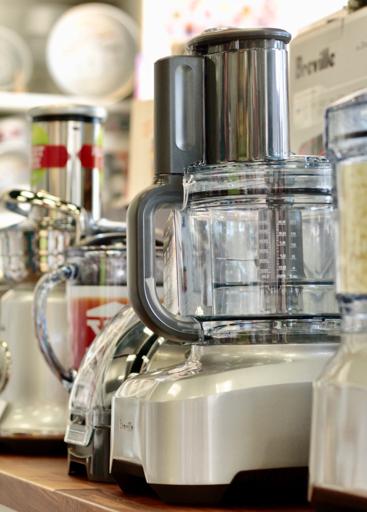




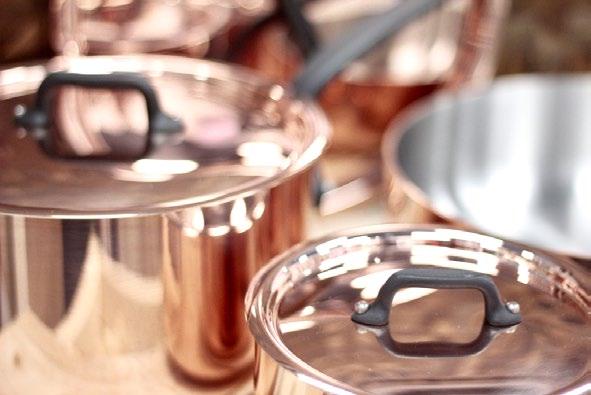



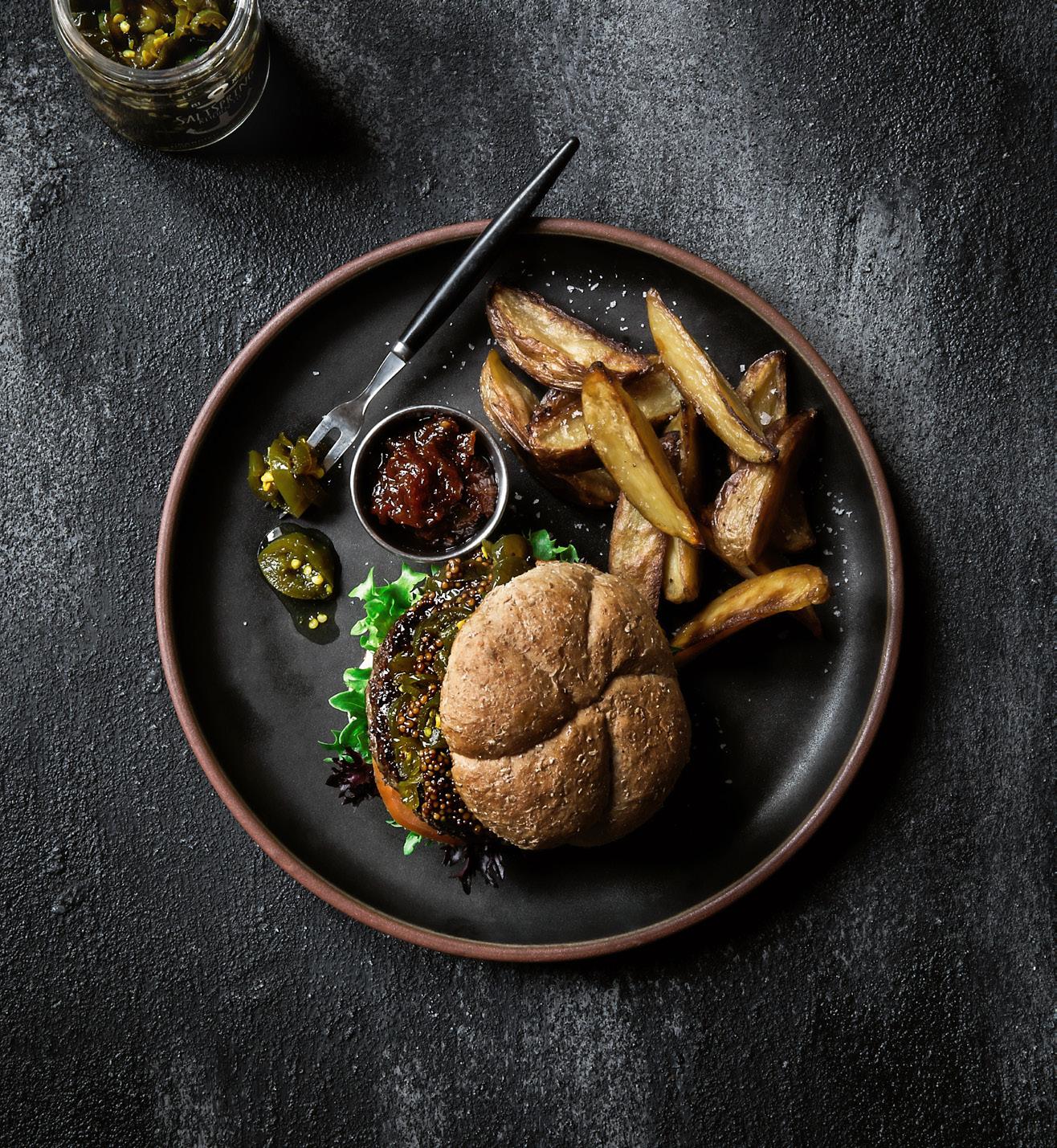





all the best tools for your kitchen NOW SHOP 11/29/19 TCOW_19-0266_EAT-Mag_Quarterpage-ad_Christmas Discover a world of flavour grown close to home. ELEVATE THE EVERYDAY WITH OUR HANDMADE PRESERVES AVAILABLE AT FINE FOOD AND GIFT STORES SALTSPRINGKITCHEN.COM 25
Grilled Eggplant, Smoky Tomato Sauce and Carrot Top Pesto with Pasta
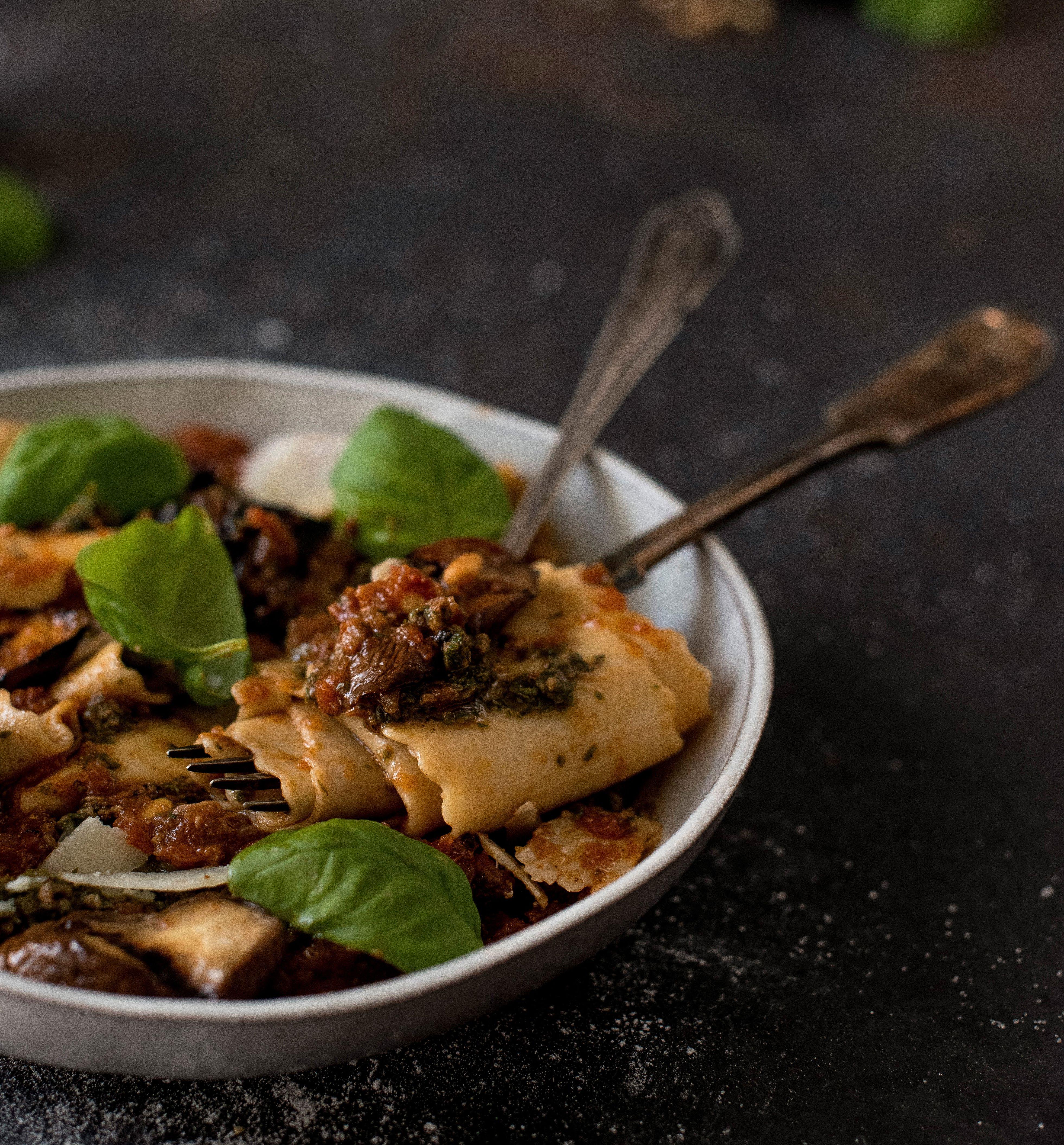
A little smoke, a little spice and a great use for a typical throw-away green Serves 4
Rebecca Wellman
I am that person who constantly scrolls through recipes and photos and reads cookbooks like novels and is a bit obsessed with all things food. So, when I came across a photo that had no recipe attached, but appeared to be a beautiful pasta dish with pesto, tomato sauce and eggplant, I felt I needed to bring it to life. While I can’t take full credit for the idea of this recipe, I have created elements that come together in a lovely way, but can also be utilized independently. Use the smoky tomato sauce on a baked vegetable parmesan or with sausage, caramelized onions and mashed potatoes; the pesto on chicken or tofu; the eggplant on flatbread with burrata. The tomato sauce and pesto both freeze well, so while you are making it for this dish, you may as well make extra and pop it into the freezer for a good hit another time.
We are on the west coast, yes. And January brings with it a nip and a chill. However, that doesn’t mean we can’t roll out the grill, right? The barbecue is the perfect way to get that smoky flavour without actually having a smoker.
I suggest making the sauce at least a day before eating it, as that will allow the flavours to meld and mix and become deeper and more satisfying.
RECIPE + STYLING + PHOTOGRAPHY
26 JANUARY/FEBRUARY 2020
Carrot Top Pesto
Makes 2 cups
2 cups tightly packed fresh basil leaves
1 cup packed green carrot tops, tough stems removed
1 garlic clove
2 Tbsp red miso paste
1 Tbsp lemon juice
½ cup toasted walnuts
¾ cup olive oil
Sea salt and freshly ground pepper
Place all ingredients into a food processor and pulse until all of the ingredients are well blended, but there is a bit of texture. Season with freshly ground pepper. (The miso should be salty enough, but add more salt if you like).
Smoky Tomato Sauce and Eggplant
(Can be done up to 2 days ahead)
Makes about 5 cups of sauce
2 cups hickory chips soaked for 20 minutes, drained
3lb (about 16) large Roma tomatoes, halved lengthwise, seeds removed
2 medium yellow onions, peeled and halved
5 large cloves garlic, peeled
Sea salt
4 Chinese or Japanese eggplant, cut diagonally into 1/2 -inch slices
¼ cup olive oil, plus more for coating eggplant
1 ½ tsp smoked paprika
3 cups chicken broth, preferably homemade
½ cup dry red wine
3 Tbsp tomato paste
Pinch chili flakes or a shake of hot sauce
Grated Parmesan cheese, fresh basil leaves and toasted pine nuts to serve
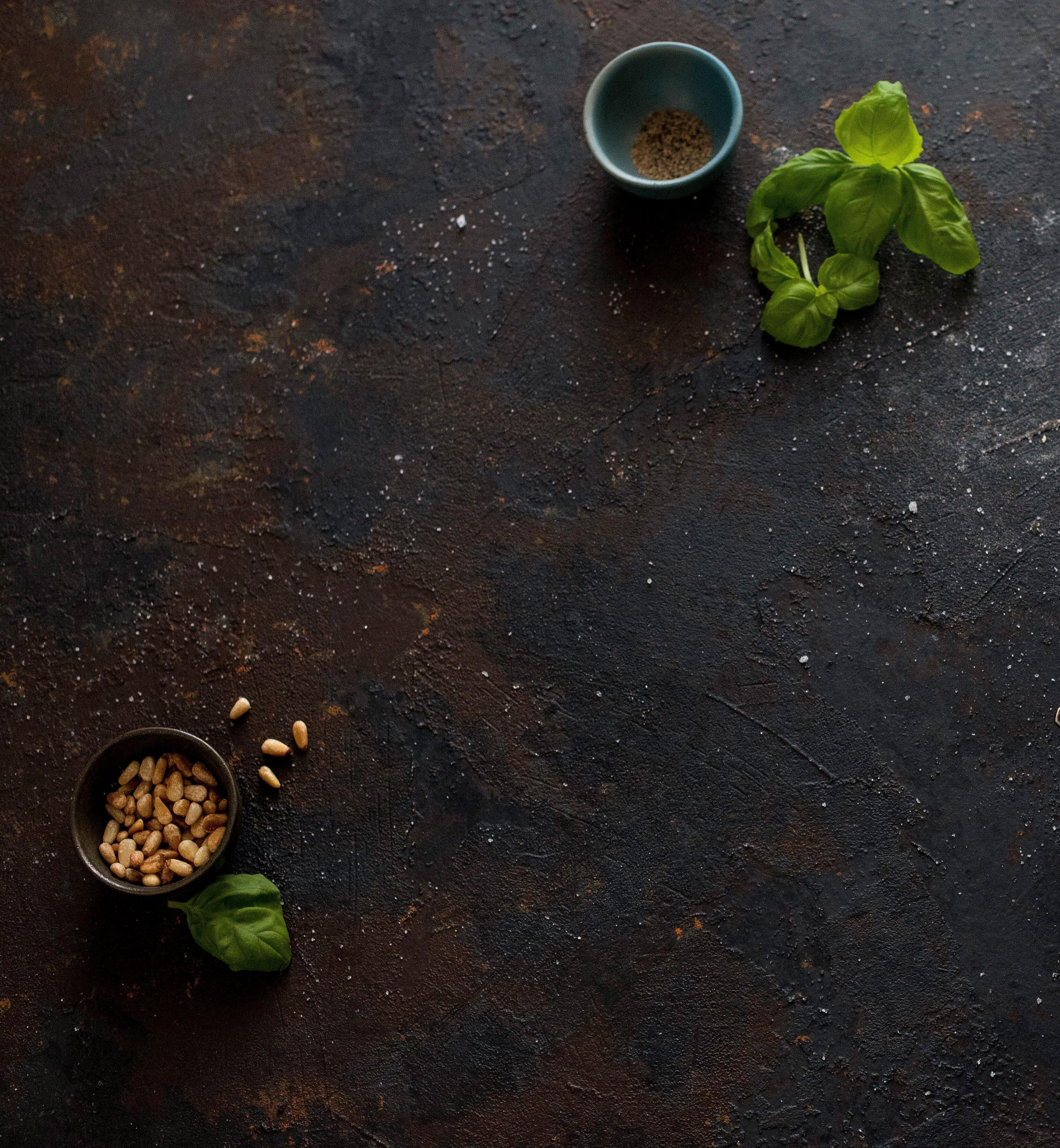
Set BBQ to high on one side and leave the heat off on the other. Lightly oil the unheated side of the grill. Place hickory chips in a small foil pan on the heated side and tomatoes and onions, cut side up, on the unheated side. Place garlic cloves on a small piece of tin foil and place on unheated side as well. Close the cover and leave it closed for about 20 minutes. Vegetables should be softened (onions and garlic won’t be fully cooked) and nice and smoky.
In the meantime, place eggplant on a large sheet pan lined with parchment and sprinkle with salt. Let sit for 15 minutes, then using your hands, coat with a bit of olive oil and sprinkle with some freshly ground pepper.
Remove onions, tomatoes and garlic from the BBQ into a large bowl, discard hickory chips and heat both sides of the grill to mediumhigh. Place eggplant slices on the BBQ and grill for about 2 minutes, on each side. Remove from heat to a large plate. (Cover and refrigerate if making in advance.)
Place tomatoes, onions and garlic (remove any stems if necessary) in the bowl of a food processor, add up to 1 tablespoon of salt (start with 2 teaspoons, taste, and add more if you feel it needs more. Remember, there is almost 5 pounds of vegetables here; they can take it!) and pulse until well combined with just a bit of texture. Add olive oil to a large pot over low heat. Sprinkle in paprika and stir for about 20 seconds until it sizzles a little. Pour in tomato mixture and add chicken stock, red wine, tomato paste and chili flakes or hot sauce. Simmer gently for at least two hours, taste and season with salt and pepper. (Cool and refrigerate if making in advance.)
To serve, heat the sauce and the eggplant. Cook a batch of long pasta, such as papardelle, fettuccine or any other favourite. (Or make your own! See Denise Marchessault’s Masterclass on page 19).
Toss hot pasta with tomato sauce, fold in some eggplant and top with a few dollops of pesto, freshly grated Parmesan, basil leaves and pine nuts.
27
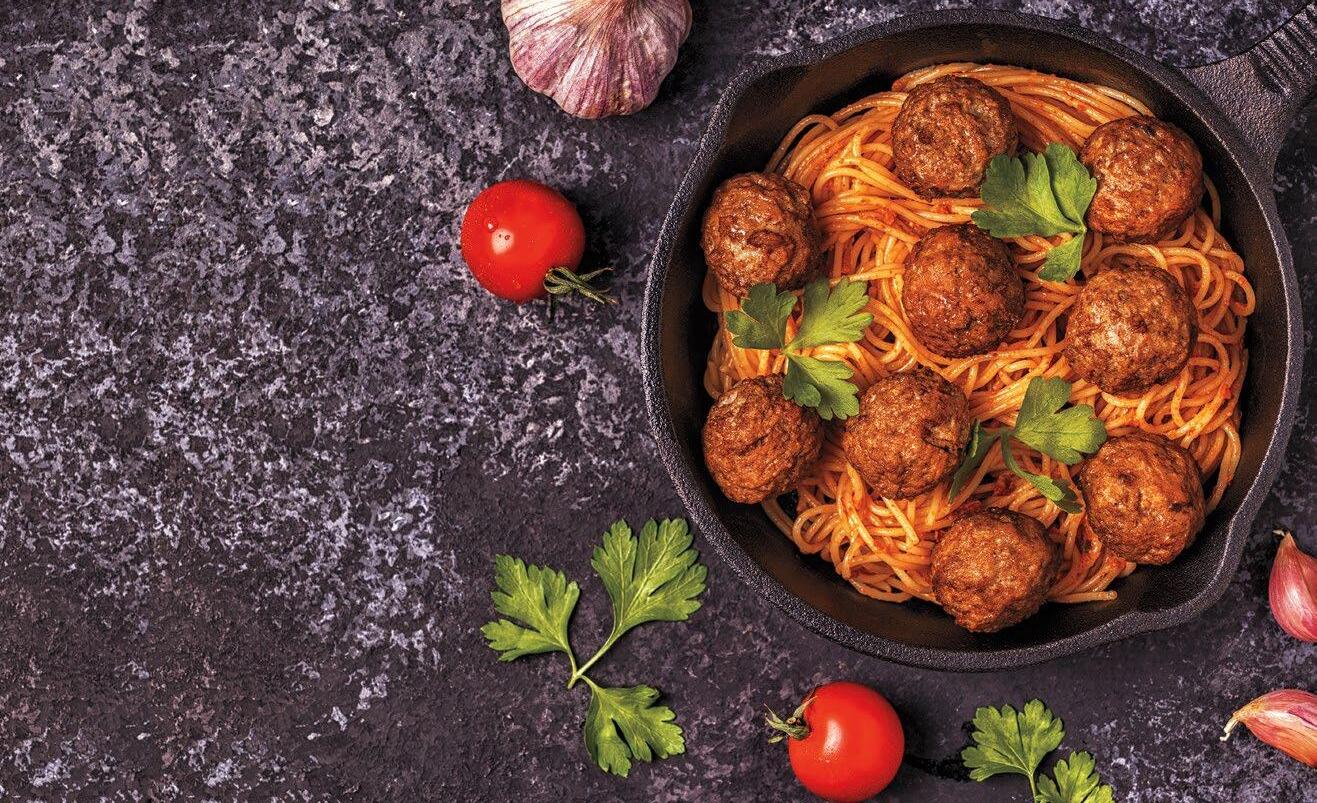
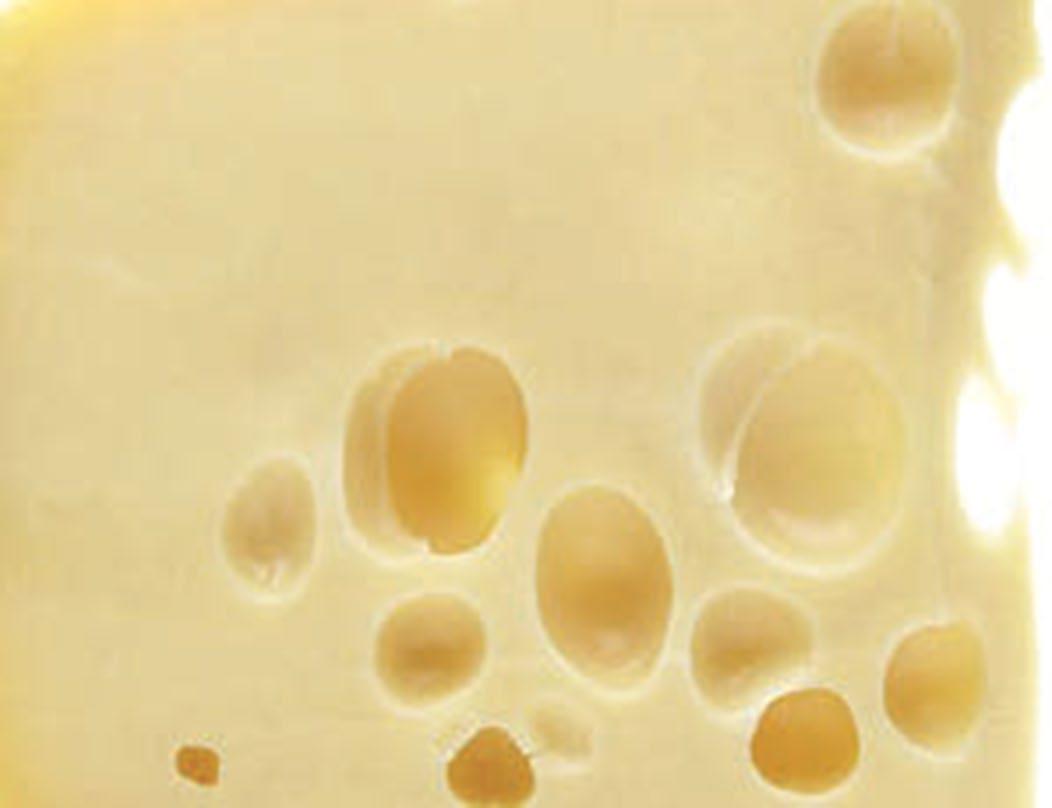





Slaters FIRST CLASS MEAT 1983 LTD. Big on meaty meatballs! Comfort food we’ve got you covered. 250.592.0823 ∙ 2577 Cadboro Bay Road Welcome to a Food Lover’s Paradise • Exotic Cheese and Chutneys • Truffles, Olives and Pates • Gourmet Oils and Vinegars • British, European and South African Imported Foods 250-754-0100 426 Fitzwilliam Street the bigcheese@ mcleansfoods.com www.mcleansfoods.com Established 1992 in Nanaimo’s Old City Quarter In Nanaimo’s Old City Quarter WE WISH YOU A HAPPY AND HEALTHY NEW YEAR! Thank you all for your continued patronage from all of us at Adrienne's! Open daily! 250-658-1535 rediscover the Blue Crab Local, fresh and healthy breakfast, lunch and dinner offerings that will make you shellebrate! COAST VICTORIA HOTEL & MARINA BY APA | RESERVE AT BLUECRAB.CA OR CALL 250.480.1999 250.590.7424 VISAVISOAKBAY.COM @VISAVISOAKBAY 28 JANUARY/FEBRUARY 2020
SOBER CURIOUS: The Rise of Low Booze
Ican’t quite recall where I first heard about the plan, but I do know that I attempt it every year following a busy holiday season of merrymaking. It’s quite simple, really. It’s one month a year, one week a month, and one day a week of no drinking alcohol whatsoever, an intermittent teetotalling lifestyle that would have delighted the American Temperance Society a hundred years ago. It might not seem like much, but all combined, the plan adds up to a little more than four months of booze-free living annually—a solid third of the year.
I use the word “attempt” on purpose though. Generally what happens is that while I start off strong, once the sun reappears in spring—only a few months into the plan—the opportunities to socialize over a casual drink start to increase. Someone invites me for a post-work beverage during my week of no drinking that month, and because I’ve been hibernating all winter and I work alone and if I don’t go out I might not see a human that day, I just think, “Oh, I’ll take next week off.” But then it happens again the following week and before you know it, the entire regimen is shot.
Of course, this is about will power and a consideration for one’s health—but it’s more than that. It’s a social obligation of sorts. It shouldn’t be strange for one adult to meet another adult in a pub or a restaurant bar and not drink alcohol, but it often feels that way. Go ahead, invite a friend out for a beer and when you get there just drink tea and see what happens. My bet is that unless you are completely off alcohol all of the time, you’ll get at least some pushback. People want to share the experience and part of that is drinking together. It’s ritualistic. There’s camaraderie in it.
Part of the problem was that until very recently, the options for no-alcohol beverages have been extremely limited, which has added to the awkwardness. Shirley Temples. Arnold Palmers. Cranberry sodas. I don’t know about you, but when given the option between a glass of wine and a mocktail I used to drink when I was seven years old, I’m unlikely to choose the Temple. It’s hard to sit alongside a friend enjoying an adult beverage while you scrape maraschino cherry wax from your teeth.
Fortunately, for those of us attempting to indulge in a drinking sabbatical, change is afoot. A growing trend of low to no-alcohol beverages is emerging in Victoria and throughout North America, making it easier to keep to the plan.
THESE DAYS, LESS IS MORE
The International Wines and Spirits Record (IWSR), a widely used source for alcohol trends globally, reports that 25- to 44-year-olds are “significantly trying to reduce their alcohol intake.” In fact, the market for bottled low
WORDS
Adrien Sala
and no-alcohol beverages in the U.S. is expected to grow by about 32 percent between 2018 and 2022—triple the category’s growth over the previous five years. Whether this is due to an ever-growing health and wellness trend, or to a more open conversation about substance abuse, mental health, and the long-term impacts of heavy drinking (or, most likely, a combination of it all), the resulting outcome is that there are distilleries, bars, restaurants, and liquor stores now offering less boozy options for folks looking to cut back on their consumption.
In many locations around town, including Sherwood Café & Bar, The Fernwood Inn, Garrick’s Head, and a long list of other pubs, restaurants, and liquor stores, a craft beer from Ontario called Partake is becoming popular. Partake offers a pale, a blonde, a stout, and an IPA—and all of them are 0.3%, low enough in alcohol that you can buy them at a grocery store. To be fair, Partake has a different mouthfeel and is lighter than traditional craft beers, but the flavour and carbonation are there, so it feels somewhat the same.
If a low (rather than no) alcohol beer is more what you’re after, those options are growing as well. InBev, the giant conglomerate beer company that owns more than 400 brands worldwide, has pledged to increase its global beer volumes of no or low-alcohol to 20 percent by the end of 2025. More locally, Whistle Buoy Brewery in Market Square has several beers in the 4% range. Hoyne Brewing has plans to release a low-alcohol beer in the spring, but even today a good part of their lineup remains at the lower end of the spectrum when it comes to ABV (alcohol percentage by volume). And Vancouver Island Brewery has a grapefruit gose radler called Magic Hour that clocks in at 2.4%.
It’s not just beer companies that are getting in on the low to no-alcohol game. Co-founder of award-winning Sheringham Distillery, Alayne MacIsaac, recently launched Lumette! a no-alcohol spirit brand whose first offering is Bright Light Alt-Gin. The alt-gin (another way of saying no alcohol) is herbaceous, woodsy, and has botanicals including the classic gin juniper, grand fir, grapefruit, mint, and more.
“For me, it matters that we provide an equally inspiring non-alcoholic option to cocktail lovers everywhere,”
says MacIsaac. “Despite owning a distillery, I’m not a big drinker.”
Lumette! is designed to substitute for traditional gin in a mixed drink, such as with tonic or as a sour. Launched in the fall in many of the same private liquor stores and restaurants that carry Sheringham, Lumette! is already becoming well known by cocktail fans who choose not to drink alcohol for any number of reasons, such as myself when I’m on the plan, or if a person is pregnant or has to drive.
SAME, SAME, BUT DIFFERENT
The growing trend of low to no-alcohol options is helping diminish the stigma of mocktailing, too. The Trounce Alley trifecta of Tapa Bar, Bodega, and Poco have put real effort into designing drinks using shrubs, non-alcoholic syrups made of a combination of concentrated fruits, aromatics, sugar, and vinegar for acidity. At the time of writing, they have an interesting range of made-in-house shrubs including a fig, a mixed berry, a cranberry spice, and a carrot tarragon.
Shrubs can be used in both alcoholic and non-alcoholic cocktails. For the latter, they allow a bartender to mix something creative, providing the customer an experience that goes beyond the boring and traditional non-alcoholic beverages. You can easily make shrubs at home or find them in liquor stores, specialty shops, or even online. Often shaken and served in cocktail glasses, there is no discernible difference between a shrub-based cocktail with or without booze. In fact, if you were to order a shrub at Tapa Bar there’s a good chance that only you and the bartender would know there isn’t alcohol in your drink.
“I had a guy come in and ask for a non-alcoholic mixed drink a little while ago,” says Ginette Gauthier, bar manager at Tapa Bar. “He basically whispered it to me, like he was embarrassed to order it.” Gauthier made him a mocktail using one of the shrubs as a base and the customer was relieved to receive it in a cocktail glass. He’d not had a shrub before and was even happier to discover that he could order one without having to face the scrutiny of his companions who would be none the wiser about his mocktail.
There are many reasons a person might choose not to drink. It may be just a short hiatus for resolute reasons or it may be for a different reason altogether, but it is certain you should never pry as to why. If a person doesn’t want to drink, leave it at that. The most important thing is the experience, whether it has alcohol in it or not. Hopefully, with the rise of low to no-alcohol beverage options increasing, the conversation will shift toward it being normal to have a non-alcoholic cocktail and focus more on spending time with people you care about. For me, it certainly helps with sticking the plan.
29
With the new year upon us and resolutions bouncing between friends and allies, writer Adrien Sala examines one of the toughest to tackle: sober January—and how the growing trend of low to no-alcohol beverages might help us get through it.
The Simple Fix
A quick and satisfying pasta dish to warm both hearts and bellies.
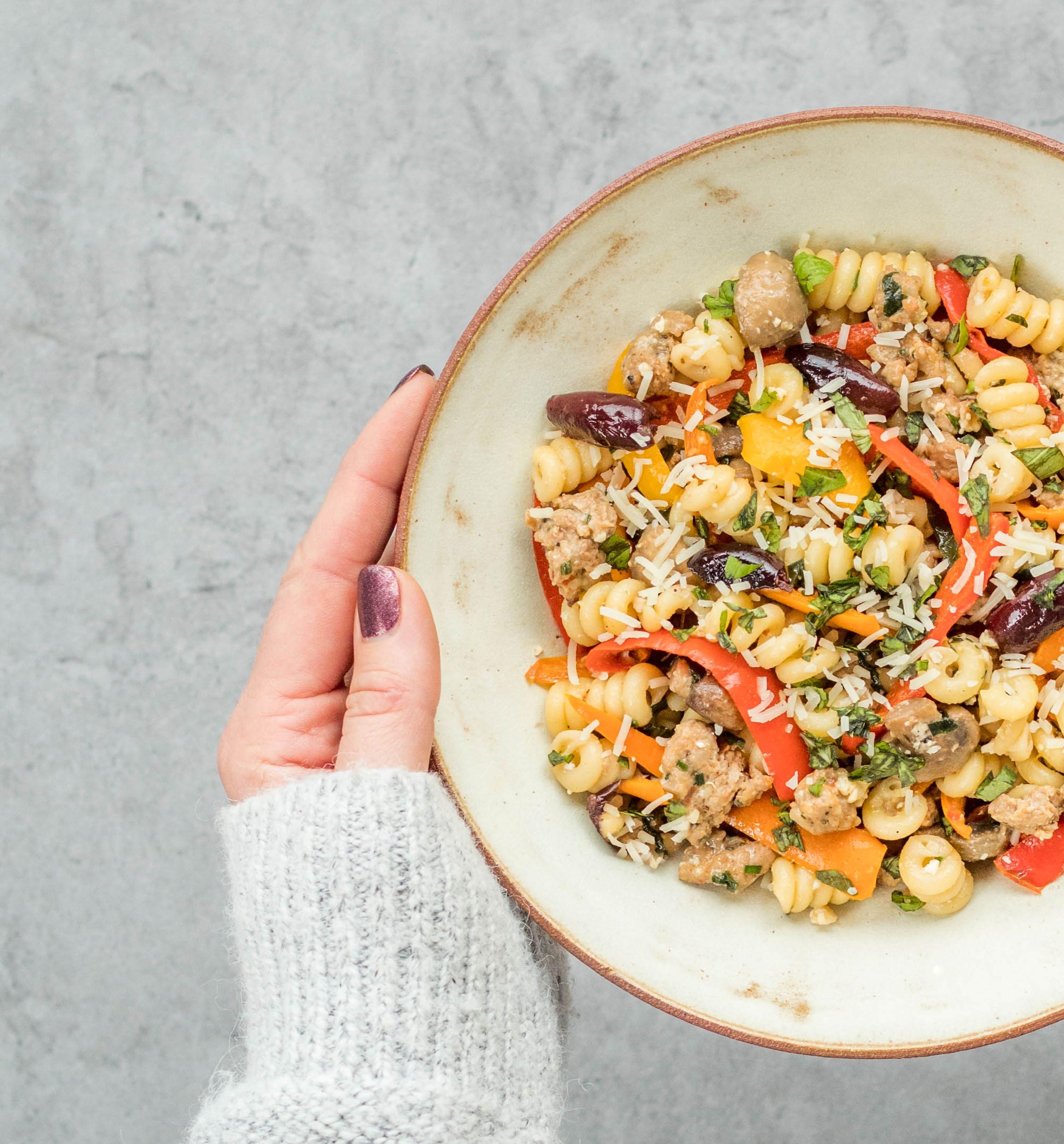
30
2020
JANUARY/FEBRUARY
On a cold winter day, a rich plate of pasta can soothe the soul and provide much needed warmth when the sun is replaced with grey skies and cold rain. This recipe serves 4 so there may be comforting leftovers for the next day too!

5 cloves garlic
1 cup pitted kalamata olives
2 Tbsp olive oil
250 g pasta (for this recipe we used Garofalo type)
2 spicy Italian sausages, casing removed
1 Tbsp butter
1 red onion, sliced
2 cups sliced crimini mushrooms
3 bell peppers of various colours, seeded and sliced Salt and freshly ground black pepper, to taste
1 cup beer (a crisp lager is recommended)
1 cup feta cheese, cut in small cubes
1 cup fresh herbs chopped (basil, chives, and parsley) Parmesan cheese, optional, to taste.
Preheat the oven to 350°F (175°C). Place the garlic and olives and 1 Tbsp of oil in a baking dish and toss to coat. Roast for 15 minutes or until the garlic is tender.
Peel and mash the garlic and set all aside in a large mixing bowl.
Boil a pan of salted water and cook the pasta al dente according to the instructions on the package. Drain and set aside.
Crumble the meat of the sausages in a frying pan. Sauté over medium-high heat for 5 minutes, stirring occasionally, until the outside is golden brown. Remove the sausage from the pan and set aside. If there is a lot of fat left in the pan, discard most of it.
Heat remaining oil and the butter in the same pan, add onion, mushrooms, and peppers and cook over medium heat for 5-8 minutes, stirring often. Once onion and peppers are slightly caramelized, season with salt and pepper, stir, and cook 1 more minute. Return the sausage to the pan together with the vegetables and pour the beer over top, letting the liquid reduce by half. Stir occasionally, about 3 minutes. Place all in a mixing bowl, add the pasta, feta, and fresh herbs. Toss well and serve in individual pasta dishes.
Serve with a glass of your favourite red wine to complete the comfort.
RECIPE + STYLING + PHOTOGRAPHY
31
Isabelle Bulota
What’s New on the Plate
A culinary compendium from top BC chefs.
ŠIsrael Alvarez , chef du cuisine at Victoria’s Breakwater Tasting Room , is trumpeting organic heirloom corn . “Importing Mexican corn to Victoria changed my career as a Mexican-Canadian chef,” says Alvarez, who for years couldn’t find a decent tortilla anywhere when he first moved to Canada. Now sourcing single origin corn from Oaxaca and Jocotitlan, Mexico, Alvarez showcases “the real flavour, texture and aroma of tortillas” using four different organic landraces of corn in yellow, white, red, and blue. In a labour-intensive and traditional process known as nixtamalization, he soaks the corn kernels in an alkaline solution for 16 hours, then rinses, hulls and hand-grinds the corn into masa. The resulting hand-pressed tacos and tostadas on his menu transport culinary and cultural mashups such as duck confit carnitas, mezcal gravlax, wild mushrooms and epazote, or snapper al pastor.
ŠSourcing from an organic farm in Cawston, BC, Lisa Ahier of Tofino’s Sobo loves to start a meal with a plate of charred shishito peppers with basil, olive oil, and salt. “We run them on the special board every night when they’re in season,” says Ahier, “sometimes with Manchego and almonds.” At other times, she’ll serve them in potato salads or on pizza with squash and fresh Qualicum cheese. “They’re simple to prepare and fun to introduce guests to,” adds Ahier. She also makes a relish called “Texas caviar,” a combination of black-eyed peas and shishitos that her restaurant serves with warm, fresh-fried tostadas. “Topped with basil and olive oil, of course.”
ŠShelome Bouvette of Vancouver’s Chicha, uses bright yellow Peruvian aji amarillo chili paste whenever she can.
“It’s bright like sunshine and so versatile,” she says. With a mild chili heat, it’s more about the flavour and colour for Bouvette. She uses it in hollandaise, to make bright yellow gnocchi, and in whipped potatoes, or causa, for the crab and shrimp dish on Chicha’s Peruvianinspired menu. She predicts, “it’s going to be a very up-and-coming ingredient in restaurants, especially in ceviche.”
ŠBaking soda , “an inexpensive, egalitarian ingredient,” is the jam for Karen Barnaby, chef, author, columnist, and product development consultant.
“Asian cooks and my favourite Israeli restaurant had told me a long time ago about using baking soda to achieve crispness, snap, and softness,” says Barnaby. “But I was too snooty at the time to really listen.” After trying many ways to get ultra-crispy skin on pork
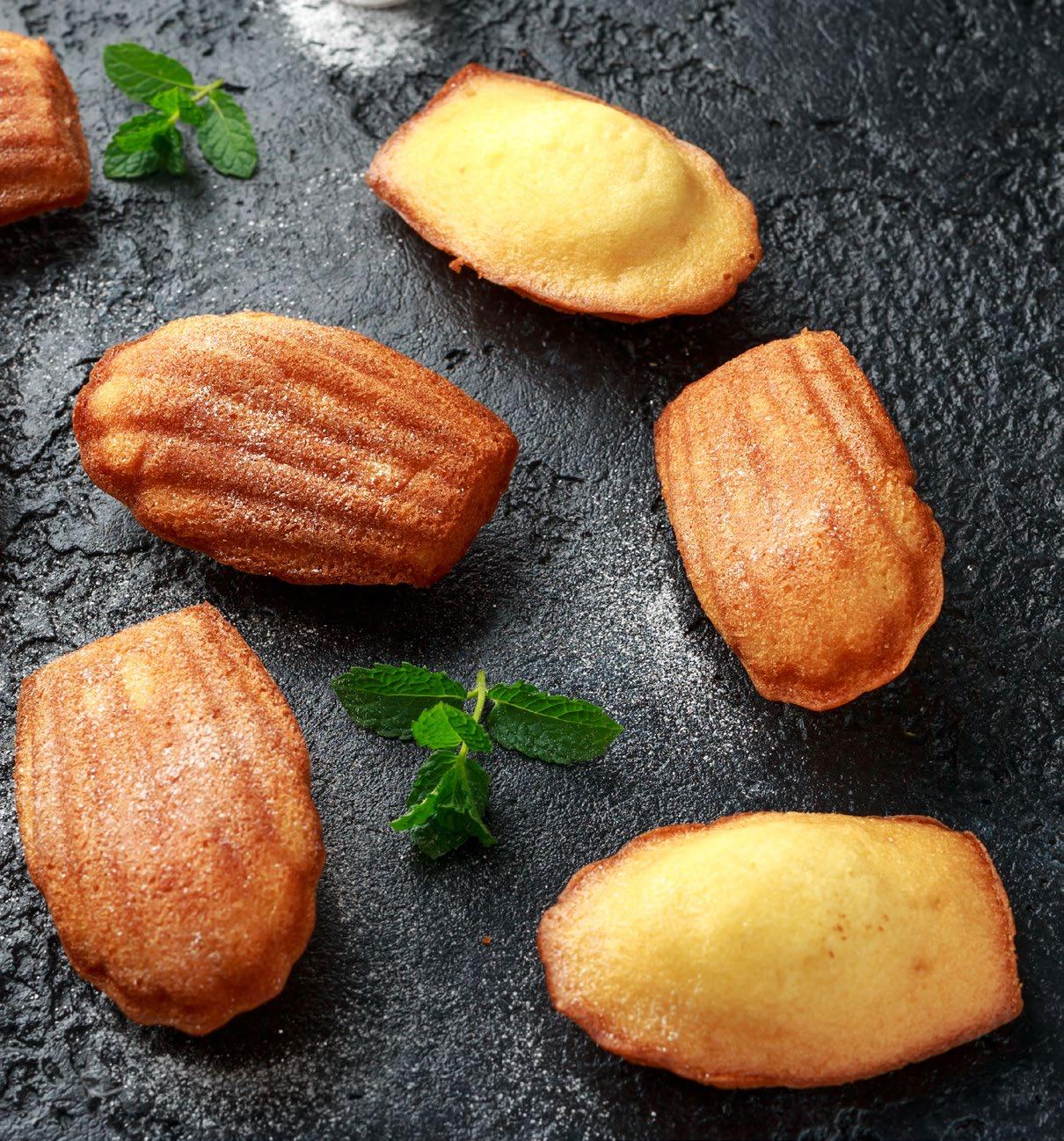
WORDS
Shelora Sheldan
belly at home, and without a combi oven, she finally caved in and tried the baking soda and salt method. “I’m now a convert,” she admits. She goes further to mention it aids in creating a perfectly crispy crust on potatoes, softens dried chickpeas for stellar hummus, and gives flaccid prawns a snappy texture.
Warren Barr of Pluvio in Ucluelet is phasing out store-bought vinegars and replacing them with housemade vinegars, citing that it’s a great way to preserve the flavours of the season. “We had great success making raspberry, strawberry, and peach vinegars,” says Barr. “We just took off a huge batch of vinegar made with Island-grown ginger from Courtenay, and I have about 30 litres of blackberry vinegar bubbling away as I write this.” His favourite so far was made with apples that grew in the backyard of the restaurant and hotel, using the resulting vinegar “with a little homemade garum (fermented fish sauce) to glaze the pork belly on our menu,” he states. “Our vinegars have lots of flavour and act like a snapshot of the season, preserving the flavour of the fruit.”
ŠClark Deutscher, of Nowhere *a restaurant and Hank’s looks to Badger Flame beets for inspiration. Specifically grown for the restaurant by Fierce Love Farm in Cordova Bay, “they have all the sweetness of beets but none of the earthiness,” says Deutscher, who cooks the elongated beets in different forms, highlighting textures and techniques. He showcases their orange and bright yellow flesh served raw and in a beetstuffed pasta dish in which he layers textures and tops the dish with a chewy, dehydrated beet slice, one that is crispy fried and a few marinated slices. In production: a beet and chocolate cake finished with beet dust.
Š
Instead of the usual new year culinary trend watch (we all know CBD oil-infused food and drink will be top of mind), we asked chefs throughout BC what ingredient or technique they’re most excited about to take them into 2020. Here’s a taste of what’s in store.
32 JANUARY/FEBRUARY 2020
Madeleines
for 2020
Kristian Eligh , chef of the new and (at time of writing) unnamed Toptable Group restaurant in Victoria, digs yuzukosho. A paste blend of chili peppers, yuzu citrus peel, and salt that’s slightly fermented, “It’s a delicious, spicy, citrusy condiment,” notes Eligh, “a flavour profile that encompasses everything I love.” The Japanese seasoning will be Eligh’s secret weapon on the restaurant’s opening menu.
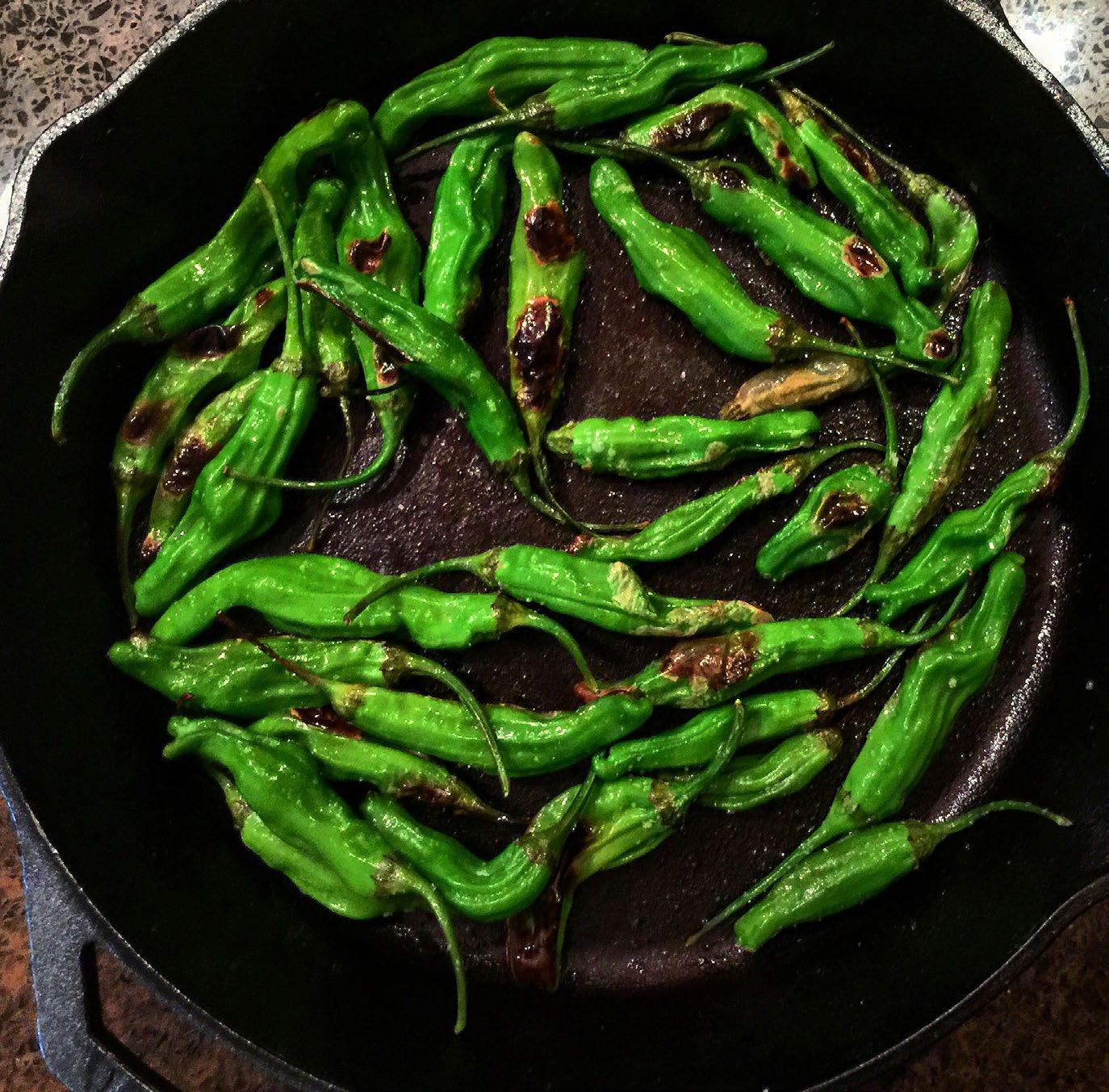

ŠBetty Hung , pastry chef and co-owner of Beaucoup Bakery in Vancouver, is inspired by Valrhona’s Inspiration yuzu couverture chocolate for “its intense aroma and flavour.” Using a high-quality, freeze-dried yuzu juice from Japan, the result is an intensely floral and citrus chocolate that is both gluten-free and vegan. Hung uses it sandwiched in between coconut or jasmine sablés (a type of French shortbread) citing that they’ll “complement each other well by adding a floral yet tart flavour to the buttery richness of the sablé.”
ŠFermenting dairy is on the roster at Wild Mountain in Sooke. By adding kefir grains to 36-percent-fat organic cream, Oliver Kienast creates a culture with a level of acidity less sharp than yogurt—a sweet, clean, and tangy quality. Once set, the culture is whipped slowly until it separates into butter and buttermilk. The butter is served with their red fife sourdough bread with Sooke sea salt, and the milk is run through a whip charger and served with the restaurant’s warm honey cake.
ŠMadeleines, the small, shell-shaped French sponge cakes, drives Dominique Laurencelle ’s inspiration at Victoria’s Boom + Batten . Infatuated with their versatility, the pastry chef uses them as the blank canvas on her dessert menu, with flavours from classic lemon, vanilla, lavender, honey, orange, and toasted sesame seeds, to savoury delicacies such as rosemary-parmesan or chorizo and smoked cheddar. “They also glaze really well,” Laurencelle explains, “which adds another flavour level.” Earl Grey tea madeleines glazed with caramelized white chocolate is one example from her repertoire to be rolled out this spring. “The possibilities are endless.”
ŠBarley koji is an “absolute blessing” for Matt Martin at Liquidity Bistro in Okanagan Falls. Locally sourced barley replaces the usual rice in koji making. Once steamed, it is inoculated with Aspergillus oryzae spores and incubated at controlled temperatures. The kitchen then makes different misos with puréed fava beans, corn, sunflower, or pumpkin seeds and their own “soya sauces” with local ingredients like pine mushrooms or rye kernels. It’s also used as a flour for breading and added to the house sourdough, producing sweet and nutty characteristics. Once mixed with salt and water, the resulting “shio koji” is also used to cure meats at Liquidity. “The enzymatic benefits help break down and tenderize meats while curing,” says Martin, “adding complex flavours.”
ŠAt Pilgrimme on Galiano Island, Jesse McCleery is taking sprouting grains a little further. Roasting and drying them slightly, the then-malted grains are used to create umami-rich syrups highlighted by their natural sweetness. “It’s a simple, low-cost process that creates some pretty versatile building blocks in our kitchen,” says McCleery. “We can take the syrups and add wild fermented vinegar or seaweeds to create glazes and so on.” The spent and sweet caramel-y grains that are leftover are then incorporated into their sprouted grain sourdough, for a flavour, notes McCleery, “similar to a Danish rugbrød.” The other bonus for McCleery is, “when we roast the sprouted grains, the kitchen has such a nice sweet warm yeast smell—just like a microbrewery.”
ŠFor Neil Taylor of Home Block at CedarCreek
Estate Winery in Kelowna, Spanish Iberico pork is in the chef’s top five food revelations after 20-plus years of cooking. Known for its great fat and marbling—but better known for its use in charcuterie, such as jamon and chorizo— Taylor has recently been able to access the uncured, fresh meat from the same Spanish Iberico pigs. “It’s perfect for our wood grill at Home Block,” says Taylor. “It’s very unique and lives up to its hype.” He loves the pork’s great flavour and fat content and serves it medium-rare. “When I first tried it, I was blown away,” admits Taylor. “The fat almost pops in your mouth—in a nice way—when you eat it. It’s like no other pork I’ve ever tried!
Š
PHOTOS (LEFT TO RIGHT) ISTOCK.COM: DRONG,
PAUL_BRIGHTON, YEHITSKAT
Aji amarillo chili sauce/paste
33
Charred shishito peppers
Three Warming Sherry Cocktails for
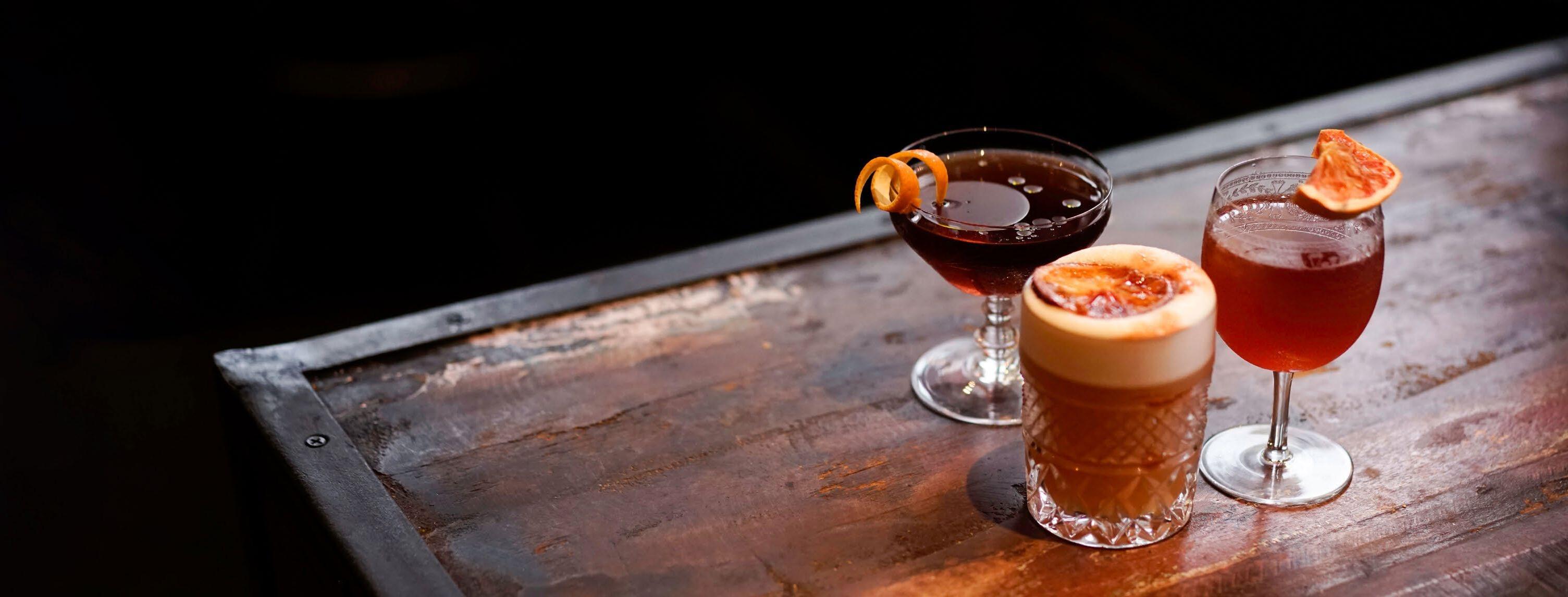
the Dead of Winter
On a crisp winter’s day, Kyle sits down with the Sherry Mavens of Bodega to learn how to stay toasty using the inherent warmth of Spain’s venerable fortified wine.
So here we are, smack dab in the middle of winter with the festive season behind us. We’re looking for a delicious way to warm up, and yet we still want to behave ourselves lest we (already) dishonour the resolutions we made for the New Year. This is where sherry cocktails come in with plenty of low-ABV possibilities.
“But isn’t sherry sickly sweet … and for grandmas? ”
Indeed, most people’s first reaction to sherry is less enthusiasm and more bewilderment. In the world of wine and spirits, sherry still rests under a cloud of obscurity—but here’s the thing:
While the sweet part can be true, it’s certainly not just for grandmas.
I recently had a chat with the team of women over at Bodega Tapas and Wine Bar (none of whom are grandmas) who are paving the way to sherry enlightenment for discerning diners and drinkers in Victoria. “It’s not just your grandma’s sweet and gnarly sherry,” says Bodega bartender Chili Berisoff. “It’s ancient and trendy, something you’ve never thought about, and now you’ll never forget.”
Part of what makes sherry magic is its varied range of flavour—the palate-cleansing saline of manzanillas and finos; the rich roasted nutty coffee and molasses of olorosos; the viscous fig and date notes of Pedro Ximénez. Few categories in the wine and spirit world enjoy such diversity.
What Makes Sherry Unique
All of sherry’s complexities and dynamism comes from natural processes. Many people think the qualities they’re tasting are a result of some kind of post-production (e.g., aromatization), as with vermouth, but it’s actually all from the soil, the grapes, and how the wine is treated and aged. Considering the Palomino grapes that are used in most sherries are very neutral, “it’s full-on alchemy,” says Bodega bartender Ellie Chapple
For example, the chalky, bone-dry qualities of a fino are a result of albariza, a very dry type of soil with amazing water retention capabilities and made of a mix of chalk, limestone, clay, and sand. At the other end of the spectrum, the viscous, rich, and raisin notes of a Pedro Ximénez come from a process known as asoleo in which the grapes are dried out by the sun, which reduces the water weight of the grape and increases the concentration of sugar, giving way to a much sweeter experience.
And of course, I’d be remiss if I didn’t mention perhaps the most unique aspect of the sherry production process—the aging. Sherry is aged in a solera system, which means that younger wines are aged and nursed in barrels at the top of the system, and trickle down to mix with older wines at the bottom over the course of three to nine steps. This ensures consistency in characteristics of the sherry and provides it with the nutrients it needs to form a layer of yeast, known as flor, at the top. This prevents oxidation for the drier varieties. Each sherry gets its unique identity from the way a solera system is set up.
Today, we’ll be exploring three cocktails that romanticize the inherent winter notes of sherry.
Exploring Sherry Through Cocktails
First, what do I mean when I say “winter notes”? In Wine Folly: An Essential Guide to Wine, authors Madeline Puckette and Justin Hammack explain how every category of wine has a spectrum of possible flavours. Here are the notes from the sherry category I would consider “wintery”:
Winter Notes of Sherry
Š Almond
Š Molasses
Š Black Walnut
Š Brazil Nut
Š Peanut
Š Toffee
Š Chocolate
Š Caramel
Š Vanilla
Š Fudge
Š Wood Varnish
Š Date
Š Fruitcake
Š Fig
Š Raisin
Š Apricot
Š Orange Peel
Š Cardamom
Š Fennel
Š Gingerbread
Š Olive Oil
In other words, the perfect flavours for warming us up when it’s cold.
While sherry is still largely misunderstood, cocktails are the perfect vehicle to introduce yourself to the unique peculiarities of this fortified wine. But before graduating to the drinks below, you may want to ease yourself in by subbing some sherry for vermouth in traditional classics like the Manhattan, Negroni, and Martini. Not only is this an accessible means of dipping your toes into the world of sherry, it’s also an easy way of giving your classic cocktails an instant Spanish flourish— arrrrriba!
WORDS + PHOTOGRAPHY
Kyle Guilfoyle
34 JANUARY/FEBRUARY 2020
Left to right: Diamond in the Rough, Valenia Sour, Pearls of Wisdom
Sherry Cocktail Recipes
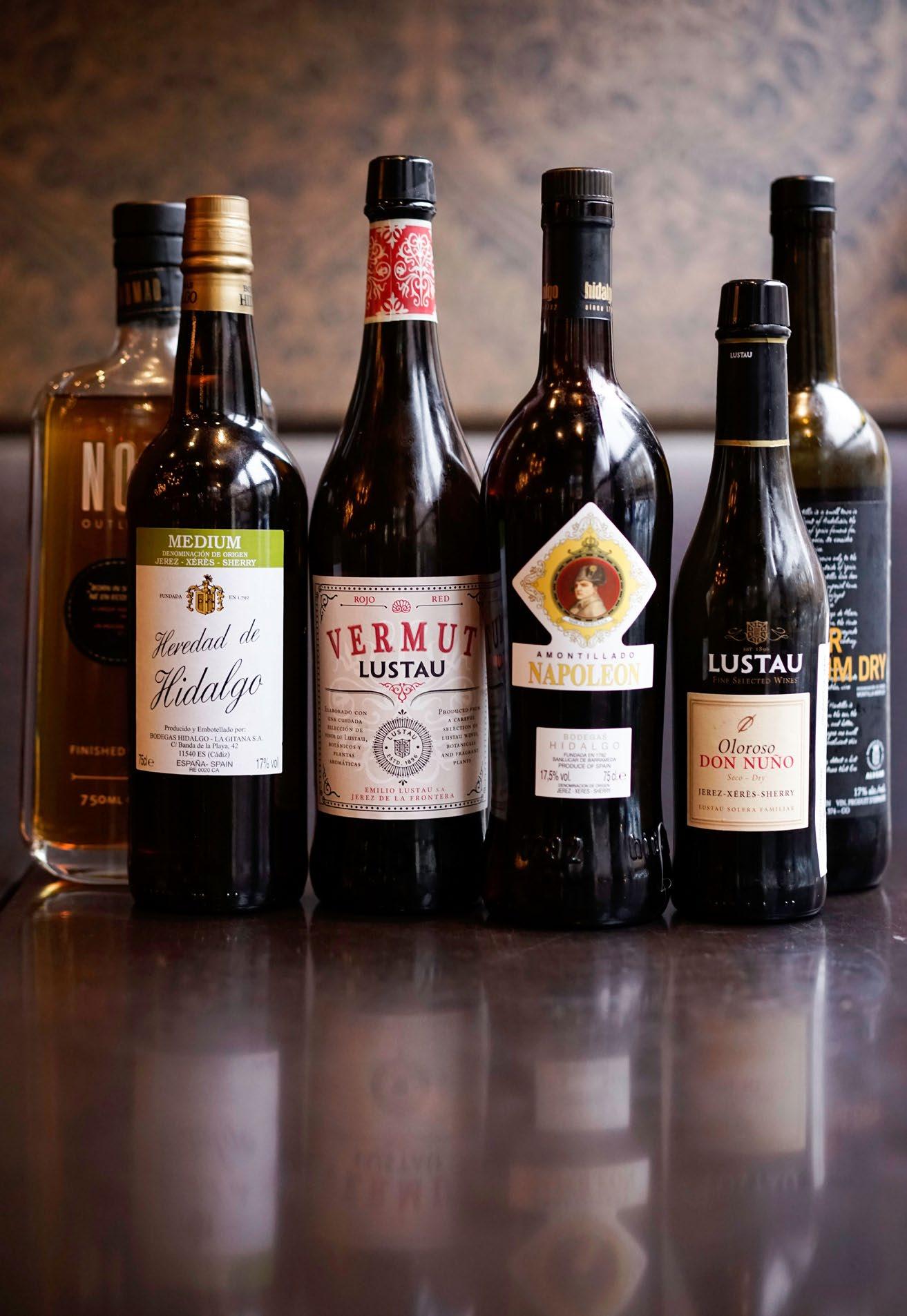
Created by the team at Bodega, these cocktails are sure to warm you up. Try making them at home, or pop into Bodega and have them take you on a sherry cocktail journey.
Diamond in the Rough
A beautiful twist on the Boulevardier classic, Diamond in the Rough is a stiff sipper that uses a light smoky whisky finished in Pedro Ximénez (PX) casks. Running with this theme even further, the cocktail uses a Spanish vermouth that’s also been aged in PX casks.
Lustau’s dry oloroso brings toffee and buttery brown sugar; Fee Brothers Black Walnut Bitters drives home the nuttiness; Campari gives it a bit of bitter orange attitude; the drizzle of blood orange olive oil on top lends a full mouthfeel and is a nod to Spanish culinary traditions.
1 oz Nomad Outland Whisky (aged in sherry butts and Pedro Ximénez casks)
½ oz Lustau Don Nuño Dry Oloroso Sherry
¼ oz Lustau Rojo (vermouth aged in Pedro Ximénez casks)
¼ oz Campari
2 dashes of Fees Brothers Black Walnut Bitters
Stir and strain into a chilled cocktail coupe. Drizzle blood orange olive oil (from Victoria’s Olive This and More) on top. Garnish with an orange twist.
Pearls of Wisdom
Featuring notes of vanilla and caramel, DeVine’s latest Dutch Courage Barrel-aged Genever gin is like a cocktail in a glass. Woods Amaro, distilled in North Vancouver, adds bright grapefruit notes that pair with almond, apple, and cinnamon tea. This is rounded out by the caramelized almond and cedarwood of Hidalgo Napoleon Amontillado Sherry.
1½ oz DeVine Dutch Courage Barrel-aged Genever
¼ oz Woods Amaro
1 oz Forever Nuts Tea Syrup (recipe below)
½ oz Hidalgo Napoleon Amontillado Sherry
¼ oz fresh lemon juice
2 dashes Fee Brothers Old Fashion Aromatic Bitters
Shake. Double strain in a cocktail coupe. Garnish with dehydrated grapefruit or a grapefruit twist.
Forever Nuts Tea Syrup
500 mL of water
500 mL of sugar
4 Tbsp of Forever Nuts tea from David’s Tea
Bring all ingredients to a boil, and let simmer for about 5-10 minutes. Strain out the tea.
Valencia Sour
This sherry cocktail is a simple bourbon sour variation that pulls the caramel and toasted orange out of the Alvear medium-dry sherry—a perfect complement to bourbon.
1½ oz bourbon
½ oz Alvear medium-dry sherry
1 oz Burnt Orange Syrup (recipe below)
1 oz fresh lemon juice
1 oz egg white
Dry shake (shake without ice to emulsify the egg white), then wet shake with ice. Double-strain neat into a rocks glass. Garnish with a candied, dehydrated orange or orange twist.
Burnt Orange Syrup
4 cups of water
4 cups of sugar
6 star anise pods
3 cinnamon sticks
12 allspice berries
1 cup of orange juice
Zest of 3 oranges
In a medium saucepan, add all ingredients except the star anise, cinnamon, and allspice. Bring mixture to a boil and then reduce temperature to let simmer.
Continue to stir and cook until it caramelizes and turns deep amber. Remove from heat and add in star anise, cinnamon, and allspice.
Kyle Guilfoyle is co-owner of the Nimble Bar Co.
35
Classic Beef Stroganoff
1 lb top sirloin steak, thinly sliced Sea salt and black pepper, to taste
2 tsp olive oil, divided
2 Tbsp butter
1 giant shallot, diced
2 garlic cloves, minced
1 lb mixed sliced mushrooms
¼ cup sour cream (use full fat—don’t skimp!)
1½ Tbsp Worcestershire sauce
1 heaping tsp Dijon mustard
1½ Tbsp all-purpose flour
1 cup beef broth
½ cup whipping cream
½ cup chopped fresh parsley
Pat meat dry with a kitchen towel. Generously season meat with salt and pepper. Heat 1 tsp oil in a Dutch oven set over medium-high heat. Add half the meat; cook just until browned, about 2 minutes—you don’t want to overcook it. Turn into a bowl; lightly wipe pan. Repeat with remaining 1 tsp oil and meat. Remove meat to the same bowl; cover with foil to keep warm.
Melt butter in a Dutch oven over mediumhigh heat. Add shallot, garlic, and mushrooms; stir often until mushrooms are lightly browned, 6-8 minutes.
Meanwhile, in a small bowl, stir together sour cream, Worcestershire sauce, and mustard. Set aside.
When mushrooms are cooked, stir in flour. Pour in broth; scrape up and stir in any
brown bits from the bottom of the pan. Stir in whipping cream. Bring to a boil, then reduce heat to medium. Gently boil until the sauce starts to thicken.
Stir in sour cream mixture and reserved meat with any juices. Simmer until warmed through. Stir in parsley and top with cabbage, if using.
DIY Eggy Pasta Noodles
In a food processor, whirl together 2 cups all-purpose flour with 2 whole eggs, 1 large egg yolk and 3 Tbsp water just until dough starts to come together.
Turn onto a floured counter and knead until smooth. Roll and shape dough into a large log. Wrap in plastic; rest for at least 1 hour. Cut dough into 4 pieces. Working with one piece at a time, roll into a large rectangle about ¼ inch thick; dust counter with more flour as needed. Don’t worry if your rectangle is uneven! Place on a baking sheet lined with a kitchen towel. Continue with remaining pieces and stack layers between more towels. One at a time, roll up each rectangle, then slice into thick ribbons. Unroll noodles, then cut cross-wise into chubby pieces. Lightly toss with flour, Boil in salted water, about 3-4 minutes.
Tip: Be sure to rest the dough at least 1 or up to 3 hours before rolling out. If refrigerating overnight, let dough come to room temperature next day before rolling out. The gluten relaxes, making it easier to roll without shrinking.

RECIPE + STYLING Jennifer Danter 36 JANUARY/FEBRUARY 2020
PHOTOGRAPHY Jacqueline Downey
Classic Beef Stroganoff
This is a rich and saucy stroganoff to serve over egg noodles, polenta, or mashed potatoes.

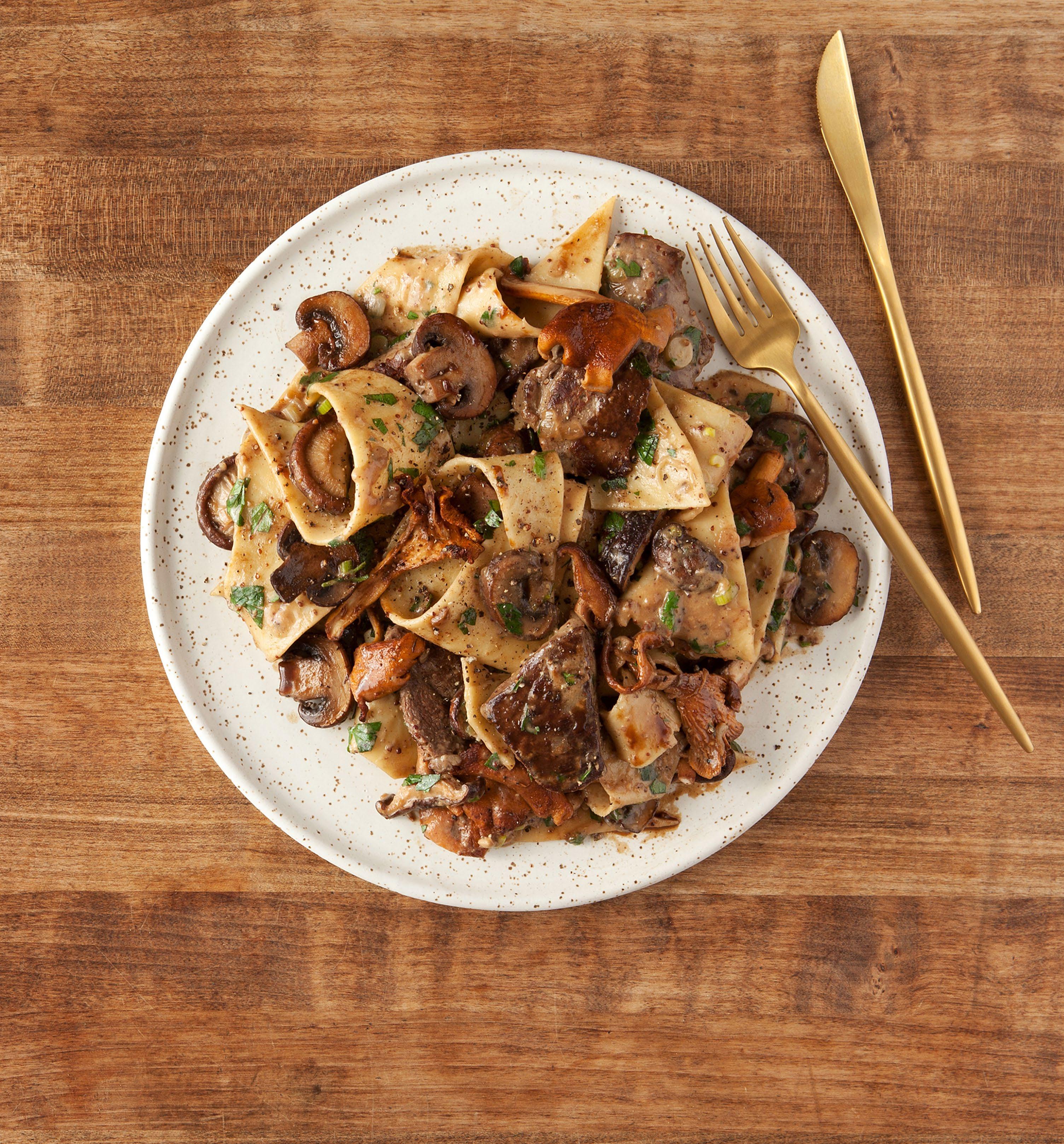
37
EUROPE’S OTHER WHITE WINES
A whole medley of whites wines exists beyond the Chardonnays, Sauvignon Blancs, and Pinot Grigios.
WHITE WINES NEED NOT BE GIVEN THE HEAVE-HO in mid-winter. Zesty mineraldriven wines are splendid with oysters at their peak in January and February. Meanwhile richer wines pair marvellously with cheesy pastas and pizzas, potato-y chowders, white meat chilies, and vegetarian stews. And I may be taken to task, but white wine surpasses red for many types of cheese any day of the year.
For a while now, white wines outside streamlined brands have been inching their way into BC wine shops and onto restaurant lists. Some wines are organic. Some are not. Many are produced in modest facilities and in moderate quantity. All speak of the place from which they come. The wines mentioned here owe their tang to briny sea or stony soil. The tongue-twisting names can be baffling and their singular styles may ruffle the palate—in a very good way.
Spain’s Cool Whites
Ulivel-la, from Masia de la Roqua winery in Olivella, about an hour’s drive from Barcelona, is named for the Catalan spelling of the old town. The wine, fresh and zesty, smacks a lot like citrus and a little like fennel. It’s a little bit salty too, and a touch yeasty from eight months’ rest on the lees before bottling. What really strikes me though is the underlying grape. It’s Xarel-lo, best known for Spain’s sparkling wine called cava (which I suggest you reach for instead of Prosecco for your next Sunday brunch). In fact, the wine conjures up white wine fizzes I’ve had, but without bubbles.
Txakoli (pronounced CHA-koh-lee) is not a grape at all but a slightly effervescent wine from Spain’s Basque region. Hondarrabi Zuri is the key grape. The consequence is a wine brimming with lime and saline. All that verve clocks in at a modest 11.5% ABV. Do as the Basques do and pour it from a height about a foot above your head. I suggest you opt for a wide–mouthed glass for this exercise. The practical reason for the high pour is to keep the spritz spritzing. It also looks very cool. However, I poured Astobiza Txakoli in the more conventional way. Astobiza isn’t quite so effervescent as some Txakoli. More to the point, though, I didn’t want to lose a smidgen of the wine’s delicious grapefruit, lime, and green apple zip.
Albariño has found firm footing on the shelf of late. Still I find it puzzles the imbiber. Albariño, (the grape and the wine) is grown and produced in Galicia, in the Rías Baixas region (pronounced REE-as BI-shas), the rainy, pine-forested area of northwest Spain where Atlantic estuaries cut sharply into granite cliffs. With its vibrant acidity and lemony character, the wine fits in almost anywhere Sauvignon Blanc does. At its best it rivals Sancerre for finesse, steely mineral, and vitality. And in the hands of winemakers like Albamar’s Xurxo Alba, considered the face of Albariño, the grape variety ticks all these boxes showing citrus, green apple, salinity, and flint. (Incidentally, right over the border in Portugal the same grape, Alvarinho, is the backbone of light and refreshing vinho verde.)
These types of crisp, energetic wines slice through fat and salt beautifully. Think tapas— grilled octopus gently bathed in olive oil, boquerones (white anchovies), Iberian ham, Spanish tortilla de patatas, grilled padron peppers, crusty bread, and a wedge of crumbly Manchego or densely blue-veined Cabrales cheeses. Or just down Albariño with a couple of fish tacos.
Under the Volcano
On a press trip to Campania in southern Italy, I fell hard for Falanghina, Fiano, and Greco di Tufo. The lyrical sounding trio derives unmistakable hits of mineral and stone via Mount Vesuvius and Campi Flegrei volcanic soils, while the region’s southern sun lends body and weight. Depending on the vineyard and producer, any or all of peach, apricot, fig, almond, and Italian herb expressions underscore the wines. Falanghina is the most affordable. Gutsier Fiano shows more obvious fruit and nut character. Prestigious, complex, and elegant Greco di Tufo is the flintiest of the three due to tufa (porous limestone). Fresh Mozzarella and tomato (Caprese) salad and spaghetti vongole behave beautifully with these wines. Recently, though, I enjoyed penne prepared risotto style with Falanghina. Broth and starch came together to form a creamy but al dente pasta finished off with a dash of butter and cream. And, of course, pizza. After all, Naples is the capital city of the Campania region.
Mad for Furmint
Szepsy Laczkó Máté made the first Aszu from furmint (pronounced fore-mint) in 1631. Eighteen generations later, Tokay Aszu still ranks amongst the world’s most luxurious sweet wines, and the Szepsy family is still producing furmint. István Szepsy Jr. gave furmint its rightful place on the modern map with a bone-dry bottling in 2000 from plantings he managed to sequester when Tokay was under state control. The wine’s richness and finesse bowled over wine pundits.
By 2003, small-hold farmers were trucking grapes to the Szent Tamás winery in Mád to make a commune wine. Ripe stone fruit, citrus peel, mineral, and honeyed hints are the hallmarks of the bone-dry style. The top-tier wines have the flesh and bones to take on sumptuous repasts like a premium white Burgundy. On my visit, a lunch in Mád’s prestigious Gusteau restaurant featuring single vineyard dry furmints proved the wine worthy of sunchoke soup with pear and basil, slices of tender roast duck breast, mangold (a type of beetroot), crisped black pudding, and millet, instead of noodles as the starchy bit. Two evenings earlier, Mád village wine stood up to more rustic but no less delicious fare—cucumber and yogurt salad, chicken paprikash, and wide egg noodles tossed with cottage cheese, smoked bacon and sour cream.
A whole medley of “other” whites wines exists beyond the Chardonnays, Sauvignon Blancs, and inevitable Pinot Grigios that must be in everybody’s fridge these days. Give herbal Grillo from Sicily or Argentinian Torrontés a try. Or affordable Picpoul de Pinet with its lemon and melon flavours from France’s LanguedocRoussillon. Burgundian Aligoté is legendary for making kir and kir royale, but light and lively enough to quaff on its own. Portuguese Arinto, often used as a blending grape, stands firmly on its own merit when done well. Go ahead. Ruffle the palate. Rest assured you will run into some tasty surprises.
Food (and Wine!) Matters JULIE PEGG
38 JANUARY/FEBRUARY 2020
Brentwood Bay Resort
Dining in the Arbutus Room
New menu marks the start of exciting changes and creative new dishes.
The Arbutus Room at Brentwood Bay Resort has been reimagined as a comfortable, relaxed space. The room’s atmosphere is welcoming and casual, replete with cedar beams and glimmering ocean views, while the detail in meal presentation and service shows an immense amount of care and attention.
Executive chef Fred Bjarnason has tailored a menu with global scope, yet with a heavy West Coast accent. French, Nordic, and Italian inflections come together in a tantalizing menu that showcases creative approaches to seafood, game, and vegetables.
Bjarnason is quick to point out that Arbutus Room’s culinary identity is the sum of many individual contributions. The kitchen reflects the inclusive staff culture of the Resort, ensuring that many of the dishes on offer are “family” recipes, refined and developed in-house. Some of the highlights:
Wok Seared Humboldt Squid (Chef de partie Joe Yi) is a version of a traditional mainland-Chinese dish: sustainably harvested squid, steamed prawn dumplings and bok choy, all bathed in a soy broth.
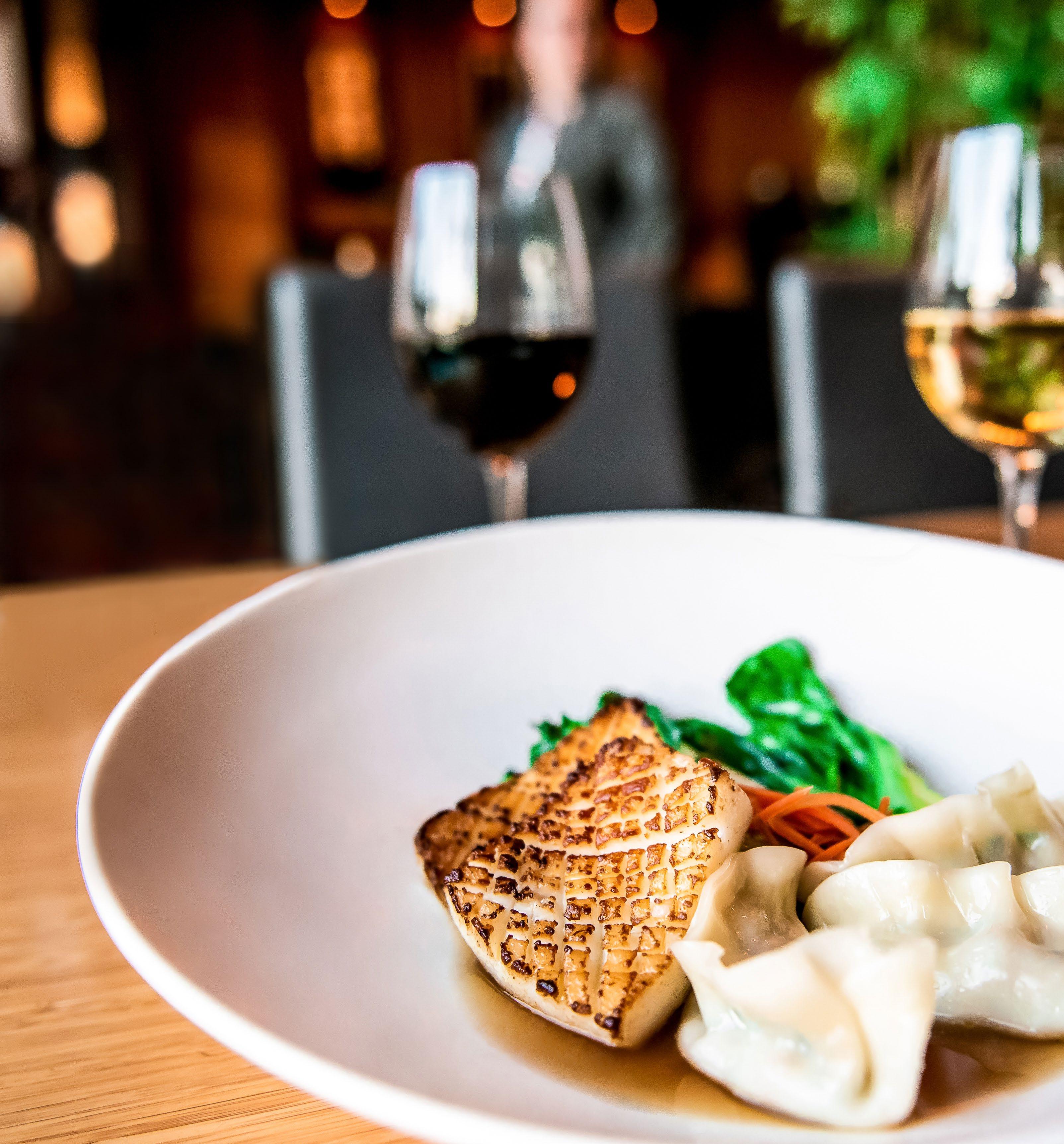
Chicken Marbella (Food and Beverage Leader Katherine Murphy) is a modern riff on the 1970s Jewish-American classic, a hearty combination of spätzle, red cabbage purée, prunes, olives, and capers.
Sheringham Gin Gravlax (Executive Chef Fred Bjarnason) pays homage to Bjarnason’s Nordic ancestry while adding an unmistakably Vancouver Island twist.
The Arbutus Room is staking a claim as a culinary destination. Luckily for Victorians it’s only a short drive away—and after a comforting meal in the tranquil, seaside ambience, you’ll be strongly tempted to stay the night—or longer.
“We believe that food creates connection. For us, each meal is a moment in time that allows us to tell the story of who and where we are.”
— Katherine Murphy, Food & Beverage Manager
EAT SPONSORED PROMOTION REUBEN BUTTERFIELD
39
from farm to fork.
















 BORN, RAISED & GRAZED IN BEAUTIFUL B.C.
BORN, RAISED & GRAZED IN BEAUTIFUL B.C.































































































































 In search of the peerless noodle in Victoria’s Italian restaurants and European-style bistros.
WORDS
Adrian Paradis
PHOTOGRAPHY
Johann Vincent
In search of the peerless noodle in Victoria’s Italian restaurants and European-style bistros.
WORDS
Adrian Paradis
PHOTOGRAPHY
Johann Vincent














































 BORN, RAISED & GRAZED IN BEAUTIFUL B.C.
BORN, RAISED & GRAZED IN BEAUTIFUL B.C.